Paul van Yperen's Blog, page 67
November 26, 2023
Alan Bates
British actor Alan Bates (1934-2003) forged his name on the West End stage in John Osborne's 'Look Back in Anger' in 1956. He also appeared in 50 films and 33 television productions, and for each role, he created a three-dimensional, unique person. With few exceptions, the talented and versatile Bates performed in premium works, guided by a pure love of acting rather than by box office.
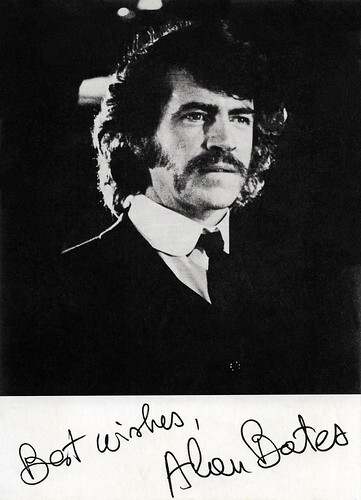
French postcard by La Roue Tourne, Paris. Photo: Alan Bates in The Go-Between (Joseph Losey, 1971).
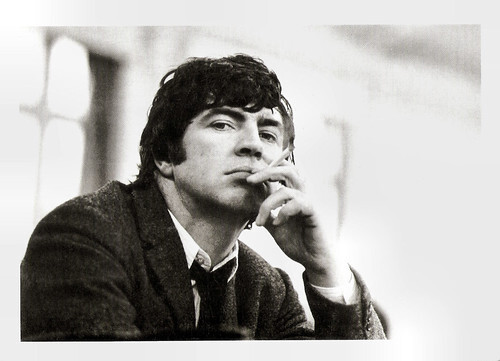
British postcard by NT (National Theatre) in the series 'Taking the Stage: an exhibition of photographs by John Haynes'. Photo: John Haynes. Alan Bates in the stage production of 'Butley' (1971) by Simon Gray at the Criterion Theatre.
Angry young men
Alan Arthur Bates was born in Allestree, England in 1934. He was the eldest of three sons of Florence Mary (née Wheatcroft), a homemaker and a pianist, and Harold Arthur Bates, an insurance broker and a cellist. Both of his parents were amateur musicians and encouraged him to pursue music, but at age 11, Alan decided to be an actor. After grammar school in Derbyshire, he earned a scholarship to the Royal Academy of Dramatic Arts in London.
Following two years in the Royal Air Force, he made his professional theatre debut with the Midland Theater Company in central England in 1955. He joined the new English Stage Company at the Royal Court Theatre, and at 22, he made his West End debut in 'The Mulberry Bush' (1956), which was also the company's first production. In the same year, Bates appeared in John Osborne's 'Look Back in Anger', a play that gave a name to a generation of postwar ‘angry young men’.
Along with Albert Finney , Richard Harris, Peter O'Toole and Tom Courtenay, Bates was one of the pioneers in the ‘kitchen sink’ drama revolution that overtook the London theatre in the 1950s: angry young men - writers, actors directors and their creations - rebelling against postwar England's middle-class values. 'Look Back in Anger' made Bates a star and launched a lifetime of his performing in works written by great modern playwrights - Harold Pinter, Simon Gray, Peter Shaffer and Tom Stoppard as well as such classic playwrights as Anton Chekhov, Henrik Ibsen, August Strindberg and William Shakespeare .
His film debut was playing one of Laurence Olivier ’s sons in The Entertainer (Tony Richardson, 1960). Bates played his first lead two years later in A Kind of Loving (John Schlesinger, 1962), where he and June Ritchie played a couple trapped in their working-class life in Manchester. He starred alongside Anthony Quinn as the young English writer, Basil, in the film for which he will always be remembered, Alexis Zorbas/Zorba the Greek (Michael Cacoyannis, 1964). Another popular success was the 'Swinging London' comedy-drama Georgy Girl (1966) with Lynn Redgrave.
Throughout the 1960s, he starred in several major films including as a fugitive in Whistle Down the Wind (Bryan Forbes, 1961), as a suburban social climber who doesn't stop at murder to secure Nothing But the Best (Clive Donner, 1964), in Le roi de coeur/King of Hearts (1966, Phillipe de Broca), and in Far From the Madding Crowd (John Schlesinger, 1967). His role opposite Dirk Bogarde in The Fixer (John Frankenheimer, 1968), based on a novel by Bernard Malamud, earned him an Academy Award nomination for Best Actor. In 1969, he became the first actor to do frontal nudity in a major studio film during an infamous wrestling session with Oliver Reed in Women in Love (Ken Russell, 1969).
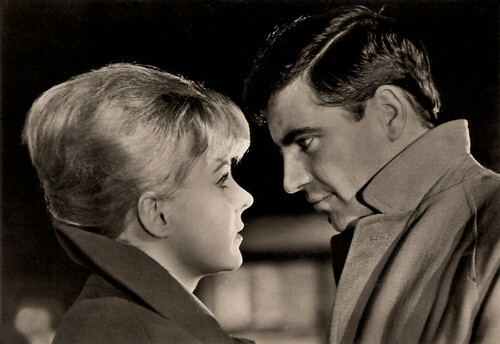
East-German postcard by VEB Progress Film-Vertrieb, Berlin, no. 1768, 1962. Retail price: 0,20 DM. Photo: Progress. Publicity still from A Kind of Loving (1962) with June Ritchie.
Versatility
Alan Bates began the subsequent decade on a very positive note, cast alongside Julie Christie as illicit lovers in The Go-Between (Joseph Losey, 1971). He was handpicked by director John Schlesinger to star in the film Sunday Bloody Sunday (1971) in the role of Dr. Daniel Hirsh. Bates was held up filming The Go-Between. He had also become a father around that time, and so he had to pass on the project. The part then went first to Ian Bannen, who balked at kissing and simulating sex with another man, and then to Peter Finch , who earned an Academy Award nomination for the role.
His versatility was again shown as the lead in Simon Gray's 'Butley', a stage comedy about an English literature professor's emotional and psychic disintegration. Bates originated the character on a London stage in 1971, did a reprise on Broadway in 1972, winning his first Tony Award, and played it again in a 1973 film. On stage, Bates had a particular association with the plays of Gray, also appearing in 'Otherwise Engaged', 'Stage Struck', 'Melon', 'Life Support' and 'Simply Disconnected'. In 'Otherwise Engaged', Bates' co-star was Ian Charleson, who became a good friend, and Bates later contributed a chapter to the 1990 book, 'For Ian Charleson: A Tribute'.
Bates would never attain the stardom of far lesser performers because of his preference for challenging and interesting work and avoidance of being type-cast. He continued to work in film and television throughout the 1970s and 1980s and starred in such international films as the dreamy fantasy The Shout (Jerzy Skolimowsk, 1978), as an intriguing but self-absorbed artist, Jill Clayburgh's bearded and ultimately spurned lover in An Unmarried Woman (Paul Mazursky, 1978), as Bette Midler's ruthless business manager The Rose (Mark Rydell, 1979), Nijinsky (1980), Britannia Hospital (Lindsay Anderson, 1984) and as Claudius in Hamlet (Franco Zeffirelli, 1990), which starred Mel Gibson .
Bryan McFarlane writes in Encyclopedia of British Cinema that "Bates went from strength to strength, even in films given the brush-off by the public: for example, the transferred stage successes, Butley (Harold Pinter, 1973) and In Celebration (Lindsay Anderson, 1974), or the undervalued Return of the Soldier (Alan Bridges, 1982)."
On television, his parts ranged from classic roles such as The Mayor of Casterbridge (1978, his favourite role he said), A Voyage Around My Father (1982), An Englishman Abroad (John Schlesinger, 1983) witty and painful as Guy Burgess, and Pack of Lies (1987) in which he played a Russian spy. He continued working in film and television in the 1990s, though most of his roles in this era were low-key.
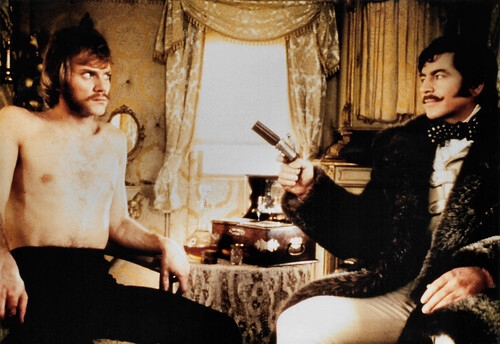
Vintage photo. Progress. Malcolm McDowell and Alan Bates in Royal Flash (Richard Lester, 1975).
A softer, still attractive maturity
In 2001, Alan Bates joined an all-star cast in Robert Altman's critically acclaimed period drama and murder mystery Gosford Park (Robert Altman, 2001), in which he played the butler Jennings bordering on breakdown. Then he appeared as a fascist who plots to bomb a Super Bowl game in the thriller The Sum of All Fears (2002), and as a mad scientist who foretells disaster in The Mothman Prophecies (Mark Pellington, 2002) starring Richard Gere .
The rumpled charm of his youth had weathered into a softer but still attractive (and still rumpled) maturity. He later played Antonius Agrippa in the TV film Spartacus (Robert Dornhelm, 2004), but died before it debuted. The film was dedicated to his memory and that of writer Howard Fast, who wrote the original novel that inspired the film Spartacus by Stanley Kubrick.
Bates had been made a Commander of the Order of the British Empire (CBE) in 1996 and was knighted in 2003. He was an Associate Member of RADA and was a patron of The Actors Centre in London from 1994 until his death in 2003. He won several theatre awards, including two Tony Awards.
Bates was married to actress and model Victoria Ward from 1970 until her death from a wasting disease in 1992. They had twin sons born in November 1970, the actors Benedick Bates and Tristan Bates. Tristan died following an asthma attack in 1990. In later years, Bates' companion was his lifelong friend, actress Joanna Pettet, his co-star in the 1964 Broadway play 'Poor Richard'. They divided their time between New York and London.
Bates had many relationships with men, including with actors Nickolas Grace and Peter Wyngarde, and Olympic skater John Curry. These were detailed in his posthumous biography, 'Otherwise Engaged' by Donald Spoto. Alan Bates died of pancreatic cancer in London in 2003. Sir Alan and his family set up the Tristan Bates Theatre at the Actors' Centre in Covent Garden, in memory of his son, Tristan, who died at the age of 19. Tristan's twin brother, Benedick, is a deputy director.
Trailer for The Shout (1978). Source: Passion4Horror (YouTube).
Trailer for Return of the Soldier (1982). Source: TapeSalvage (YouTube).
Sources: Brian McFarlane (Encyclopedia of British Cinema), Robert D. McFadden (The New York Times), (IMDb), (IMDb), BritMovie, Wikipedia, and .

French postcard by La Roue Tourne, Paris. Photo: Alan Bates in The Go-Between (Joseph Losey, 1971).

British postcard by NT (National Theatre) in the series 'Taking the Stage: an exhibition of photographs by John Haynes'. Photo: John Haynes. Alan Bates in the stage production of 'Butley' (1971) by Simon Gray at the Criterion Theatre.
Angry young men
Alan Arthur Bates was born in Allestree, England in 1934. He was the eldest of three sons of Florence Mary (née Wheatcroft), a homemaker and a pianist, and Harold Arthur Bates, an insurance broker and a cellist. Both of his parents were amateur musicians and encouraged him to pursue music, but at age 11, Alan decided to be an actor. After grammar school in Derbyshire, he earned a scholarship to the Royal Academy of Dramatic Arts in London.
Following two years in the Royal Air Force, he made his professional theatre debut with the Midland Theater Company in central England in 1955. He joined the new English Stage Company at the Royal Court Theatre, and at 22, he made his West End debut in 'The Mulberry Bush' (1956), which was also the company's first production. In the same year, Bates appeared in John Osborne's 'Look Back in Anger', a play that gave a name to a generation of postwar ‘angry young men’.
Along with Albert Finney , Richard Harris, Peter O'Toole and Tom Courtenay, Bates was one of the pioneers in the ‘kitchen sink’ drama revolution that overtook the London theatre in the 1950s: angry young men - writers, actors directors and their creations - rebelling against postwar England's middle-class values. 'Look Back in Anger' made Bates a star and launched a lifetime of his performing in works written by great modern playwrights - Harold Pinter, Simon Gray, Peter Shaffer and Tom Stoppard as well as such classic playwrights as Anton Chekhov, Henrik Ibsen, August Strindberg and William Shakespeare .
His film debut was playing one of Laurence Olivier ’s sons in The Entertainer (Tony Richardson, 1960). Bates played his first lead two years later in A Kind of Loving (John Schlesinger, 1962), where he and June Ritchie played a couple trapped in their working-class life in Manchester. He starred alongside Anthony Quinn as the young English writer, Basil, in the film for which he will always be remembered, Alexis Zorbas/Zorba the Greek (Michael Cacoyannis, 1964). Another popular success was the 'Swinging London' comedy-drama Georgy Girl (1966) with Lynn Redgrave.
Throughout the 1960s, he starred in several major films including as a fugitive in Whistle Down the Wind (Bryan Forbes, 1961), as a suburban social climber who doesn't stop at murder to secure Nothing But the Best (Clive Donner, 1964), in Le roi de coeur/King of Hearts (1966, Phillipe de Broca), and in Far From the Madding Crowd (John Schlesinger, 1967). His role opposite Dirk Bogarde in The Fixer (John Frankenheimer, 1968), based on a novel by Bernard Malamud, earned him an Academy Award nomination for Best Actor. In 1969, he became the first actor to do frontal nudity in a major studio film during an infamous wrestling session with Oliver Reed in Women in Love (Ken Russell, 1969).

East-German postcard by VEB Progress Film-Vertrieb, Berlin, no. 1768, 1962. Retail price: 0,20 DM. Photo: Progress. Publicity still from A Kind of Loving (1962) with June Ritchie.
Versatility
Alan Bates began the subsequent decade on a very positive note, cast alongside Julie Christie as illicit lovers in The Go-Between (Joseph Losey, 1971). He was handpicked by director John Schlesinger to star in the film Sunday Bloody Sunday (1971) in the role of Dr. Daniel Hirsh. Bates was held up filming The Go-Between. He had also become a father around that time, and so he had to pass on the project. The part then went first to Ian Bannen, who balked at kissing and simulating sex with another man, and then to Peter Finch , who earned an Academy Award nomination for the role.
His versatility was again shown as the lead in Simon Gray's 'Butley', a stage comedy about an English literature professor's emotional and psychic disintegration. Bates originated the character on a London stage in 1971, did a reprise on Broadway in 1972, winning his first Tony Award, and played it again in a 1973 film. On stage, Bates had a particular association with the plays of Gray, also appearing in 'Otherwise Engaged', 'Stage Struck', 'Melon', 'Life Support' and 'Simply Disconnected'. In 'Otherwise Engaged', Bates' co-star was Ian Charleson, who became a good friend, and Bates later contributed a chapter to the 1990 book, 'For Ian Charleson: A Tribute'.
Bates would never attain the stardom of far lesser performers because of his preference for challenging and interesting work and avoidance of being type-cast. He continued to work in film and television throughout the 1970s and 1980s and starred in such international films as the dreamy fantasy The Shout (Jerzy Skolimowsk, 1978), as an intriguing but self-absorbed artist, Jill Clayburgh's bearded and ultimately spurned lover in An Unmarried Woman (Paul Mazursky, 1978), as Bette Midler's ruthless business manager The Rose (Mark Rydell, 1979), Nijinsky (1980), Britannia Hospital (Lindsay Anderson, 1984) and as Claudius in Hamlet (Franco Zeffirelli, 1990), which starred Mel Gibson .
Bryan McFarlane writes in Encyclopedia of British Cinema that "Bates went from strength to strength, even in films given the brush-off by the public: for example, the transferred stage successes, Butley (Harold Pinter, 1973) and In Celebration (Lindsay Anderson, 1974), or the undervalued Return of the Soldier (Alan Bridges, 1982)."
On television, his parts ranged from classic roles such as The Mayor of Casterbridge (1978, his favourite role he said), A Voyage Around My Father (1982), An Englishman Abroad (John Schlesinger, 1983) witty and painful as Guy Burgess, and Pack of Lies (1987) in which he played a Russian spy. He continued working in film and television in the 1990s, though most of his roles in this era were low-key.

Vintage photo. Progress. Malcolm McDowell and Alan Bates in Royal Flash (Richard Lester, 1975).
A softer, still attractive maturity
In 2001, Alan Bates joined an all-star cast in Robert Altman's critically acclaimed period drama and murder mystery Gosford Park (Robert Altman, 2001), in which he played the butler Jennings bordering on breakdown. Then he appeared as a fascist who plots to bomb a Super Bowl game in the thriller The Sum of All Fears (2002), and as a mad scientist who foretells disaster in The Mothman Prophecies (Mark Pellington, 2002) starring Richard Gere .
The rumpled charm of his youth had weathered into a softer but still attractive (and still rumpled) maturity. He later played Antonius Agrippa in the TV film Spartacus (Robert Dornhelm, 2004), but died before it debuted. The film was dedicated to his memory and that of writer Howard Fast, who wrote the original novel that inspired the film Spartacus by Stanley Kubrick.
Bates had been made a Commander of the Order of the British Empire (CBE) in 1996 and was knighted in 2003. He was an Associate Member of RADA and was a patron of The Actors Centre in London from 1994 until his death in 2003. He won several theatre awards, including two Tony Awards.
Bates was married to actress and model Victoria Ward from 1970 until her death from a wasting disease in 1992. They had twin sons born in November 1970, the actors Benedick Bates and Tristan Bates. Tristan died following an asthma attack in 1990. In later years, Bates' companion was his lifelong friend, actress Joanna Pettet, his co-star in the 1964 Broadway play 'Poor Richard'. They divided their time between New York and London.
Bates had many relationships with men, including with actors Nickolas Grace and Peter Wyngarde, and Olympic skater John Curry. These were detailed in his posthumous biography, 'Otherwise Engaged' by Donald Spoto. Alan Bates died of pancreatic cancer in London in 2003. Sir Alan and his family set up the Tristan Bates Theatre at the Actors' Centre in Covent Garden, in memory of his son, Tristan, who died at the age of 19. Tristan's twin brother, Benedick, is a deputy director.
Trailer for The Shout (1978). Source: Passion4Horror (YouTube).
Trailer for Return of the Soldier (1982). Source: TapeSalvage (YouTube).
Sources: Brian McFarlane (Encyclopedia of British Cinema), Robert D. McFadden (The New York Times), (IMDb), (IMDb), BritMovie, Wikipedia, and .
Published on November 26, 2023 22:00
November 25, 2023
Heidelinde Weis (1940-2023)
On 24 November 2023, Austrian actress and singer Heidelinde Weis passed away. She appeared in several European films in the 1960s. She was a respected theatre actress in German-speaking countries and regularly appeared in TV films and series.
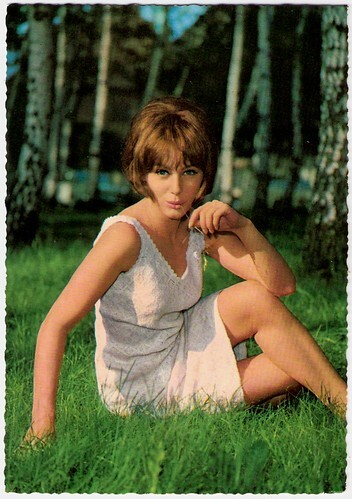
German postcard by Krüger, no. 902/381. Photo: Lothar Winkler.
Ambitious stenotypist
Heidelinde Weis was born in Villach, Austria, in 1940. She was the daughter of a mercenary’s employee and she studied at a commercial school. At 14, she played the title role in an adaptation of the fairy tale 'Hans im Glück' (Hans in the Fortune) at the Österreichischen Schulbühne (Austrian School Theatre).
After her acting studies at the Max-Reinhardt-Seminar in Wien (Vienna) in 1957-1958, she became a company member of the Wiener Theater in der Josefstadt from 1959 to 1960.
She made her film debut as an ambitious stenotypist opposite Hans Söhnker in Ich heirate Herrn Direktor/I Marry the Managing Director (Wolfgang Liebeneiner, 1960).
In real life, she married theatre producer Hellmuth Duna in 1960. From then on she toured often with his theatre company. Between 1962 and 1981 she also did guest performances, amongst others at the Theater am Kurfürstendamm, in Hamburg, Düsseldorf and at Theater in der Brienner Straße in München.
She was very successful in 'Colombe' by Jean Anouilh (also adapted for TV by Hans-Dieter Schwarze in 1965), and as Isabella in 'Maß für Maß' (Measure for Measure) and Olivia in 'Was ihr wollt' (As You Like It) by William Shakespeare . The latter was also filmed as Was Ihr wollt/As You Like It (Franz Peter Wirth, 1962). At the Salzburger Festspielen, she later played Rosetta in 'Leonce und Lena'(Leonce and Lena) (1976) and the countess in 'Der tolle Tag or Figaros Hochzeit' (1978).
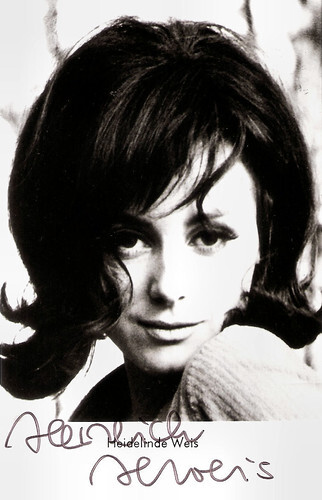
West German postcard by Franz Josef Rüdel, Filmpostkartenverlag, Hamburg. Photo: Constantin / Mangold. Heidelinde Weis in Der Lügner und die Nonne/The Liar and the Nun (Rolf Thiele, 1967).

German postcard by Franz Josef Rüdel, Hamburg. Photo: Wolfgang Pirker.
Attractive corpse
In the cinema, Heidelinde Weis had her breakthrough as the attractive corpse in Die Tote von Beverly Hills/The Corpse of Beverly Hills (Michael Pfleghar, 1964). The thriller, based on a bestseller by Curt Goetz, won the Technical Grand Prize at the Cannes Film Festival.
Next, she appeared opposite child star Hansi Kraus in the comedy Lausbubengeschichten/Tales of a Young Scamp (Helmut Käutner, 1964) based on Ludwig Thoma, and in the sequels Tante Frieda - Neue Lausbubengeschichten/Aunt Frieda – New Tales of a Young Scamp (Werner Jacobs, 1965) with Elisabeth Flickenschildt, and Onkel Filser - Allerneueste Lausbubengeschichten/Uncle Filser – Brand New Tales of a Young Scamp (Werner Jacobs, 1966) with Michl Lang.
She played the title role in the biographical costume drama Liselotte von der Pfalz (Kurt Hoffmann, 1966). Other films were the James Bond spoof Serenade for Two Spies (Michael Pfleghar, 1966) with Tony Kendall, the comedy Der Lügner und die Nonne/The Liar and the Nun (Rolf Thiele, 1967) with Curd Jürgens , and the anthology film Der Paukenspieler/The Tympanist (Volker Schlöndorf, a.o., 1967) with Hans Kraus .
She also played in the British drama The Man Outside (Samuel Gallu, 1967) with Van Heflin and she appeared opposite Angela Lansbury and Michael York in Something for Everyone (Harold Prince, 1970).

West German postcard by Franz Josef Rüdel, Filmpostkartenverlag, Hamburg. Photo: Ina Bernels, München.
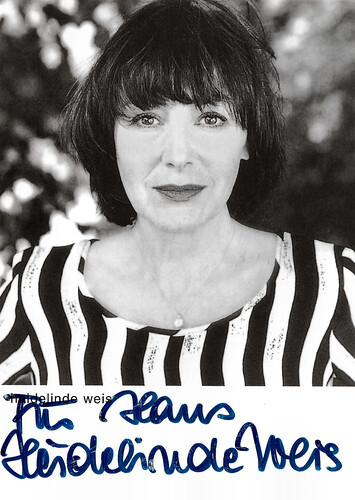
West German postcard by Franz Josef Rüdel, Filmpostkartenverlag, Hamburg. Photo: Roberto Ferrantini.
Guest starring
At the end of the 1960s, Heidelinde Weis started to focus on television. She appeared in a double role in the German miniseries Die Frau in Weiß/The Woman in White (Wilhelm Semmelroth, 1971), an adaptation of the classic mystery novel by Wilkie Collins.
In the following decades she did a lot of guest starring roles in popular Krimi series like Der Kommissar/The Inspector (1972) with Erik Ode, Derrick (1976-1988) with Horst Tappert, Der Alte/The Old Fox (1977-2002) with Michael Ande , Krimistunde/Crime Hour (1983) with Paul Dahlke , and Ein Fall für zwei/A Case for Two (1982) with Claus Theo Gärtner.
In 1975 she recorded the LP 'So sing ich' (That’s How I Sing) with self-composed songs, for which she won the German record award Deutscher Schallplattenpreis in 1976. In 1977 she won the Goldene Kamera award. In the cinema, she was seen in the Yugoslavian production Gospodjica (Vojtech Jasný, 1980).
Because of the longtime illness of her husband, her appearances in the 1980s were rare. She played on TV in Die Erbin/The Heiress (Rolf von Sydow, 1982) and in the series Schwarzwaldklinik/The Black Forest Clinic (1985). After her husband’s death in 1998, she played and directed the stage play 'Nächstes Jahr, gleiche Zeit' (Same Time, Next Year), with Heiner Lauterbach . She also returned to the TV screen in e.g. the Rosamunde Pilcher TV film adaptation, Liebe im Spiel/Love in the Game (2004) and in series like the Krimi SOKO 5113 (2008) and Das Traumschiff/The Dream Ship (2008).
She survived both breast cancer (2010) and bladder cancer (2016). In 2022, she published an optimistic autobiography, entitled 'Das Beste kommt noch' (The Best is yet to come). Sadly, she passed away on 24 November 2023 in her hometown of Villach, Kärnten, at the age of 83.
Heidelinde Weis sings 'Superman' from the LP 'So sing ich' (1975). Source: DurianKPZ (YouTube)
Italian synchronized scenes from the Derrick episode Der Mann aus Kiel/The Man from Kiel (1982). The Italian voices add to the fun. Source: Derrickclub (YouTube).
Sources: (IMDb), Stephanie D’heil (Steffi-line - German), Wikipedia (German), AllMovie and .

German postcard by Krüger, no. 902/381. Photo: Lothar Winkler.
Ambitious stenotypist
Heidelinde Weis was born in Villach, Austria, in 1940. She was the daughter of a mercenary’s employee and she studied at a commercial school. At 14, she played the title role in an adaptation of the fairy tale 'Hans im Glück' (Hans in the Fortune) at the Österreichischen Schulbühne (Austrian School Theatre).
After her acting studies at the Max-Reinhardt-Seminar in Wien (Vienna) in 1957-1958, she became a company member of the Wiener Theater in der Josefstadt from 1959 to 1960.
She made her film debut as an ambitious stenotypist opposite Hans Söhnker in Ich heirate Herrn Direktor/I Marry the Managing Director (Wolfgang Liebeneiner, 1960).
In real life, she married theatre producer Hellmuth Duna in 1960. From then on she toured often with his theatre company. Between 1962 and 1981 she also did guest performances, amongst others at the Theater am Kurfürstendamm, in Hamburg, Düsseldorf and at Theater in der Brienner Straße in München.
She was very successful in 'Colombe' by Jean Anouilh (also adapted for TV by Hans-Dieter Schwarze in 1965), and as Isabella in 'Maß für Maß' (Measure for Measure) and Olivia in 'Was ihr wollt' (As You Like It) by William Shakespeare . The latter was also filmed as Was Ihr wollt/As You Like It (Franz Peter Wirth, 1962). At the Salzburger Festspielen, she later played Rosetta in 'Leonce und Lena'(Leonce and Lena) (1976) and the countess in 'Der tolle Tag or Figaros Hochzeit' (1978).

West German postcard by Franz Josef Rüdel, Filmpostkartenverlag, Hamburg. Photo: Constantin / Mangold. Heidelinde Weis in Der Lügner und die Nonne/The Liar and the Nun (Rolf Thiele, 1967).

German postcard by Franz Josef Rüdel, Hamburg. Photo: Wolfgang Pirker.
Attractive corpse
In the cinema, Heidelinde Weis had her breakthrough as the attractive corpse in Die Tote von Beverly Hills/The Corpse of Beverly Hills (Michael Pfleghar, 1964). The thriller, based on a bestseller by Curt Goetz, won the Technical Grand Prize at the Cannes Film Festival.
Next, she appeared opposite child star Hansi Kraus in the comedy Lausbubengeschichten/Tales of a Young Scamp (Helmut Käutner, 1964) based on Ludwig Thoma, and in the sequels Tante Frieda - Neue Lausbubengeschichten/Aunt Frieda – New Tales of a Young Scamp (Werner Jacobs, 1965) with Elisabeth Flickenschildt, and Onkel Filser - Allerneueste Lausbubengeschichten/Uncle Filser – Brand New Tales of a Young Scamp (Werner Jacobs, 1966) with Michl Lang.
She played the title role in the biographical costume drama Liselotte von der Pfalz (Kurt Hoffmann, 1966). Other films were the James Bond spoof Serenade for Two Spies (Michael Pfleghar, 1966) with Tony Kendall, the comedy Der Lügner und die Nonne/The Liar and the Nun (Rolf Thiele, 1967) with Curd Jürgens , and the anthology film Der Paukenspieler/The Tympanist (Volker Schlöndorf, a.o., 1967) with Hans Kraus .
She also played in the British drama The Man Outside (Samuel Gallu, 1967) with Van Heflin and she appeared opposite Angela Lansbury and Michael York in Something for Everyone (Harold Prince, 1970).

West German postcard by Franz Josef Rüdel, Filmpostkartenverlag, Hamburg. Photo: Ina Bernels, München.

West German postcard by Franz Josef Rüdel, Filmpostkartenverlag, Hamburg. Photo: Roberto Ferrantini.
Guest starring
At the end of the 1960s, Heidelinde Weis started to focus on television. She appeared in a double role in the German miniseries Die Frau in Weiß/The Woman in White (Wilhelm Semmelroth, 1971), an adaptation of the classic mystery novel by Wilkie Collins.
In the following decades she did a lot of guest starring roles in popular Krimi series like Der Kommissar/The Inspector (1972) with Erik Ode, Derrick (1976-1988) with Horst Tappert, Der Alte/The Old Fox (1977-2002) with Michael Ande , Krimistunde/Crime Hour (1983) with Paul Dahlke , and Ein Fall für zwei/A Case for Two (1982) with Claus Theo Gärtner.
In 1975 she recorded the LP 'So sing ich' (That’s How I Sing) with self-composed songs, for which she won the German record award Deutscher Schallplattenpreis in 1976. In 1977 she won the Goldene Kamera award. In the cinema, she was seen in the Yugoslavian production Gospodjica (Vojtech Jasný, 1980).
Because of the longtime illness of her husband, her appearances in the 1980s were rare. She played on TV in Die Erbin/The Heiress (Rolf von Sydow, 1982) and in the series Schwarzwaldklinik/The Black Forest Clinic (1985). After her husband’s death in 1998, she played and directed the stage play 'Nächstes Jahr, gleiche Zeit' (Same Time, Next Year), with Heiner Lauterbach . She also returned to the TV screen in e.g. the Rosamunde Pilcher TV film adaptation, Liebe im Spiel/Love in the Game (2004) and in series like the Krimi SOKO 5113 (2008) and Das Traumschiff/The Dream Ship (2008).
She survived both breast cancer (2010) and bladder cancer (2016). In 2022, she published an optimistic autobiography, entitled 'Das Beste kommt noch' (The Best is yet to come). Sadly, she passed away on 24 November 2023 in her hometown of Villach, Kärnten, at the age of 83.
Heidelinde Weis sings 'Superman' from the LP 'So sing ich' (1975). Source: DurianKPZ (YouTube)
Italian synchronized scenes from the Derrick episode Der Mann aus Kiel/The Man from Kiel (1982). The Italian voices add to the fun. Source: Derrickclub (YouTube).
Sources: (IMDb), Stephanie D’heil (Steffi-line - German), Wikipedia (German), AllMovie and .
Published on November 25, 2023 22:00
November 24, 2023
Ellen Kürty
Ellen Kürty a.k.a. Ellen Kürti (1903-1930) was a Hungarian-born actress who had a short career in the Hungarian and German silent cinema. Between 1920 and 1928, she appeared in both leading and supporting roles in over 20 silent films. In 1930, she probably committed suicide.
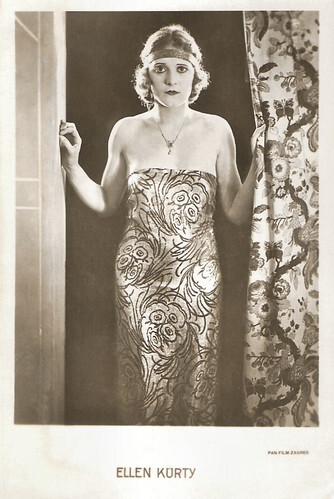
Yugoslavian postcard by Jos. Caklovic Bromografia, Zagreb, no. 17. Photo: Pan-Film, Zagreb.

Yugoslavian postcard by Jos. Caklovic Bromografia, Zagreb, no. 3. Photo: Pan-Film, Zagreb. Ellen Kurty in Mädchen, die man nicht heiratet/Girls You Don't Marry (Géza von Bolváry, 1924).
A blossoming film career in Germany
Little is known about the short life of Ellen Kürty a.k.a. Ellen Kürti a.k.a. Böske Kürthy a.k.a. Alice Pickford. She was born Erzsébet Kürthy in 1903 in Budapest, Hungary. She completed her schooling in Hungary and studied at the dance academy of Emilia Nirschy.
According to Hungarian Wikipedia , she debuted as Alice Pickford in the film A levágott kéz/The Severed Hand (Lajthay Károly, 1920). However, IMDb credits both Alice Pickford and Erzsébet Kürthy in the cast, so one of the sources is probably incorrect.
In Hungary, she also appeared opposite Vilma Banky in Veszélyben a pokol/Danger in Hell (Béla Balogh, 1921) and Galathea (Béla Balogh, 1921). Her final Hungarian film was A keselyü/The Vulture (Félix Vanyl, 1922), in which she was credited Böske Kürthy. Following the First World War, Hungary underwent a period of profound political upheaval and many people in the film industry left the country.
At only 19, Kürty continued her blossoming film career in Germany, first in Munich at the Emelka Film Studio and later at the Bavaria Film Studio. Among her first German films were Um Liebe und Thron/For Love and the Throne (Franz Osten, 1922) and Das rollende Schicksal/The Wheels of Destiny (Franz Osten, 1923) starring Colette Brettel .
In the following four years, she played a number of supporting and leading roles in Bavarian productions. She starred in the comedy Mädchen, die man nicht heiratet/Girls You Don't Marry (Géza von Bolváry, 1924) with Karl Beckersachs , She also played alongside film debutant Heinz Rühmann in the melodrama Das deutsche Mutterherz/The Heart of a German Mother (Géza von Bolváry, 1926). Her other Bavarian films include Die Liebe der Bajadere/The Love of the Bajadere (Géza von Bolváry, 1926), and Die Ehe einer Nacht (Robert Wohlmuth, 1927).
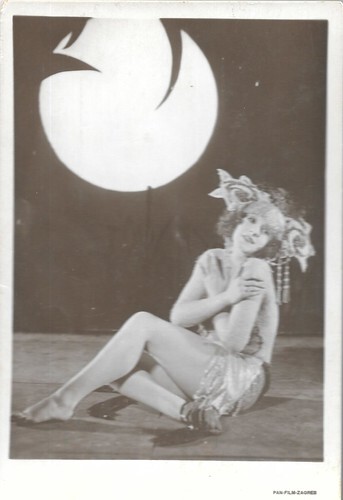
Yugoslavian postcard. Photo: Pan-Film, Zagreb. Collection: Didier Hanson.
Poisoning
Around 1927, Ellen Kürty went to Berlin, where she played leading roles in mostly minor productions. An exception was Richard Oswald 's ambitious political production Feme/Assassination (1927) starring Hans Stüwe and Grete Mosheim .
She also appeared in the silent drama Erinnerungen einer Nonne/Memoirs of a Nun (Arthur Bergen, 1927) starring American actress Mary Nolan and in Dutch director Jaap Speyer's Hotelratten/Hotel Rats (1927) with Nils Asther and Mia Pankau .
Already in 1928, after a tiny role in the Henny Porten comedy Liebe und Diebe/Love and Thieves (Carl Froelich, 1928), Ellen Kürty's career was over. She made over 20 films in Germany.
Just before the sound film era began, Ellen Kürty retired from the film business. In September 1930, a Budapest newspaper wrote that Kürthy had poisoned herself because she had not been offered a new film contract.
Although the newspaper did not report on the outcome of the poisoning, Hungarian Wikipedia assumed that she died then. Ellen Kürty was only 27.
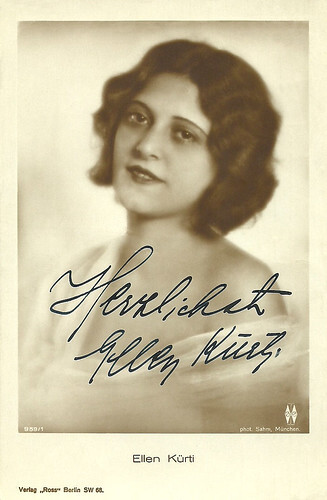
German postcard by Verlag Ross, Berlin, no. 959/1, 1925-1926. Photo: Sahm, München (Munich) / Emelka. Collection: Didier Hanson.

German postcard by Verlag Ross, Berlin, no. 959/2, 1925-1926. Photo: Sahm, München (Munich) / Emelka.
Sources: Wikipedia (Hungarian, German and English) and .

Yugoslavian postcard by Jos. Caklovic Bromografia, Zagreb, no. 17. Photo: Pan-Film, Zagreb.

Yugoslavian postcard by Jos. Caklovic Bromografia, Zagreb, no. 3. Photo: Pan-Film, Zagreb. Ellen Kurty in Mädchen, die man nicht heiratet/Girls You Don't Marry (Géza von Bolváry, 1924).
A blossoming film career in Germany
Little is known about the short life of Ellen Kürty a.k.a. Ellen Kürti a.k.a. Böske Kürthy a.k.a. Alice Pickford. She was born Erzsébet Kürthy in 1903 in Budapest, Hungary. She completed her schooling in Hungary and studied at the dance academy of Emilia Nirschy.
According to Hungarian Wikipedia , she debuted as Alice Pickford in the film A levágott kéz/The Severed Hand (Lajthay Károly, 1920). However, IMDb credits both Alice Pickford and Erzsébet Kürthy in the cast, so one of the sources is probably incorrect.
In Hungary, she also appeared opposite Vilma Banky in Veszélyben a pokol/Danger in Hell (Béla Balogh, 1921) and Galathea (Béla Balogh, 1921). Her final Hungarian film was A keselyü/The Vulture (Félix Vanyl, 1922), in which she was credited Böske Kürthy. Following the First World War, Hungary underwent a period of profound political upheaval and many people in the film industry left the country.
At only 19, Kürty continued her blossoming film career in Germany, first in Munich at the Emelka Film Studio and later at the Bavaria Film Studio. Among her first German films were Um Liebe und Thron/For Love and the Throne (Franz Osten, 1922) and Das rollende Schicksal/The Wheels of Destiny (Franz Osten, 1923) starring Colette Brettel .
In the following four years, she played a number of supporting and leading roles in Bavarian productions. She starred in the comedy Mädchen, die man nicht heiratet/Girls You Don't Marry (Géza von Bolváry, 1924) with Karl Beckersachs , She also played alongside film debutant Heinz Rühmann in the melodrama Das deutsche Mutterherz/The Heart of a German Mother (Géza von Bolváry, 1926). Her other Bavarian films include Die Liebe der Bajadere/The Love of the Bajadere (Géza von Bolváry, 1926), and Die Ehe einer Nacht (Robert Wohlmuth, 1927).

Yugoslavian postcard. Photo: Pan-Film, Zagreb. Collection: Didier Hanson.
Poisoning
Around 1927, Ellen Kürty went to Berlin, where she played leading roles in mostly minor productions. An exception was Richard Oswald 's ambitious political production Feme/Assassination (1927) starring Hans Stüwe and Grete Mosheim .
She also appeared in the silent drama Erinnerungen einer Nonne/Memoirs of a Nun (Arthur Bergen, 1927) starring American actress Mary Nolan and in Dutch director Jaap Speyer's Hotelratten/Hotel Rats (1927) with Nils Asther and Mia Pankau .
Already in 1928, after a tiny role in the Henny Porten comedy Liebe und Diebe/Love and Thieves (Carl Froelich, 1928), Ellen Kürty's career was over. She made over 20 films in Germany.
Just before the sound film era began, Ellen Kürty retired from the film business. In September 1930, a Budapest newspaper wrote that Kürthy had poisoned herself because she had not been offered a new film contract.
Although the newspaper did not report on the outcome of the poisoning, Hungarian Wikipedia assumed that she died then. Ellen Kürty was only 27.

German postcard by Verlag Ross, Berlin, no. 959/1, 1925-1926. Photo: Sahm, München (Munich) / Emelka. Collection: Didier Hanson.

German postcard by Verlag Ross, Berlin, no. 959/2, 1925-1926. Photo: Sahm, München (Munich) / Emelka.
Sources: Wikipedia (Hungarian, German and English) and .
Published on November 24, 2023 22:00
November 23, 2023
Bing Crosby
American singer Bing Crosby (1903-1977) was a crooner whose signature song was 'White Christmas'. He often played 'happy-go-lucky fellas' in films which included the 'Road to...' comedies from 1940 to 1962, but he proved that he could act with The Country Girl (1954) opposite Grace Kelly. Crosby was a multi-media entertainer: a star on the radio, and in the cinema, with chart-topping recordings. He had 38 no. 1 singles, which surpassed Elvis Presley and The Beatles.
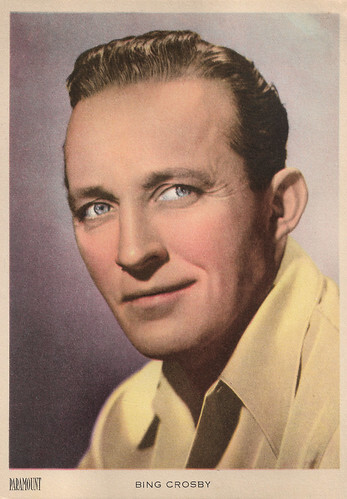
Uruguayan postcard by CF. Photo: Paramount.
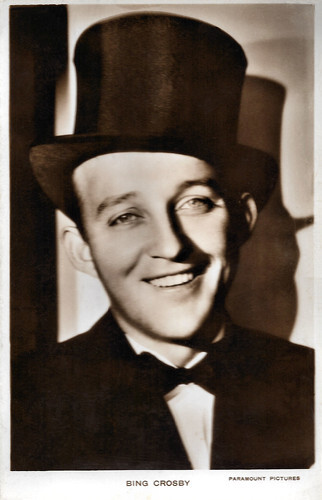
British postcard, sent by mail in 1935. Photo: Paramount Pictures.
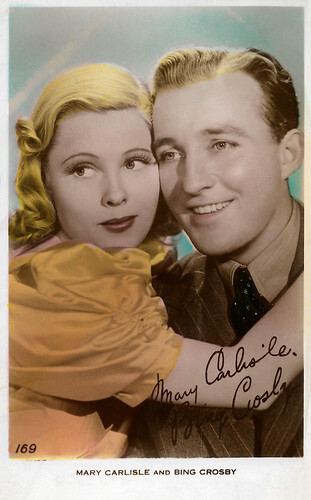
British postcard by Art Photo, no. 169. Mary Carlisle and Bing Crosby in Doctor Rhythm (Frank Tuttle, 1938).
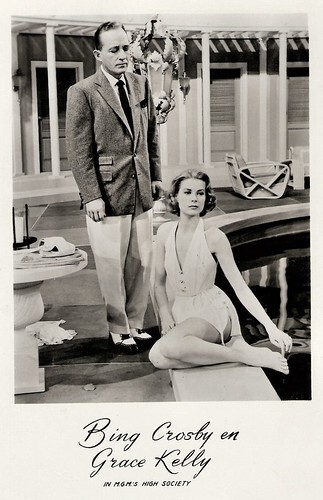
Dutch postcard by Takken, no. 3015. Photo: MGM. Bing Crosby and Grace Kelly in High Society (Charles Walters, 1956).
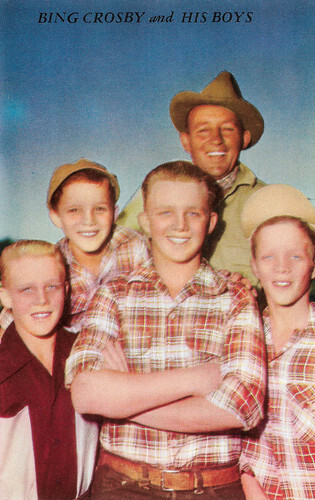
American Candid Color Card, Beverley Hills, Calif., no. A 39. Photo: Bud Fraker / Paramount. Caption: Bing Crosby, Paramount's great star, and husband of Dixie Crosby, and their four sons: Gary Evan, born June 25, 1933; twins Phillip Land and Dennis Michael, born July 13, 1934, and Lindsay Harry, born Jan. 5, 1938.
White Christmas
Bing Crosby was born Harry Lillis Crosby, Jr. in Tacoma, Washington, in 1903. He was the fourth of seven children of Catherine Helen "Kate" (Harrigan) and Harry Lowe Crosby, a brewery bookkeeper.
Crosby studied law at Gonzaga University in Spokane but was more interested in playing the drums and singing with a local band. Bing and the band's piano player, Al Rinker, left Spokane for Los Angeles in 1925.
In the early 1930s, Bing's brother Everett sent a record of Bing singing 'I Surrender, Dear' to the president of CBS. His live performances from New York were carried over the national radio network for 20 consecutive weeks in 1932.
His radio success led Paramount Pictures to include him in the musical comedy The Big Broadcast (Frank Tuttle, 1932), a film featuring radio favourites. His songs about not needing a bundle of money to make life happy had the right message for the decade of the Great Depression. He was the star of such radio shows as 'Kraft Music Hall' (1935-1946), 'Philco Radio Time' (1946-1949), 'The Bing Crosby Chesterfield Show' (1949-1952), and 'The Bing Crosby Show' (1954-1956).
His song 'White Christmas' became the bestselling single for more than 50 years until overtaken in 1997 by 'Candle in the Wind', Elton John 's tribute to the late Princess Diana.
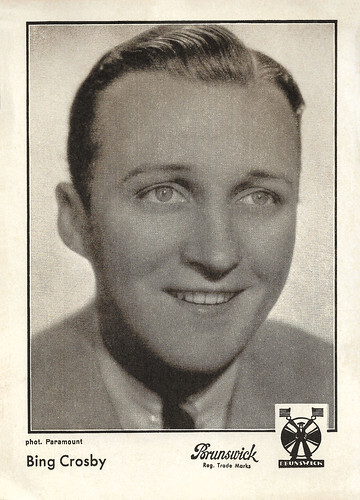
American postcard by Brunswick. Photo: Paramount.
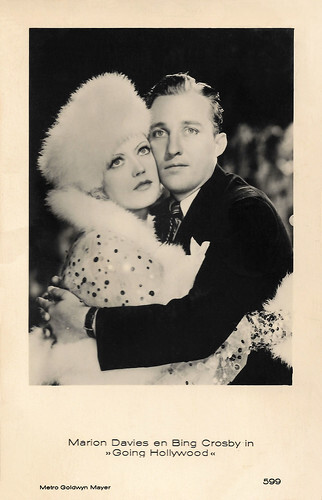
Dutch postcard, no. 599, sent by mail in 1934. Photo: Metro-Goldwyn-Mayer. Marion Davies and Bing Crosby in Going Hollywood (Raoul Walsh, 1933).
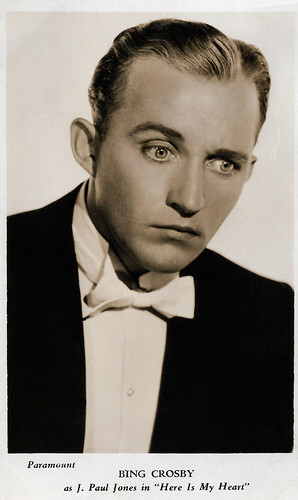
British card. Photo: Paramount. Bing Crosby as J. Paul Jones in Here Is My Heart (Frank Tuttle, 1934).
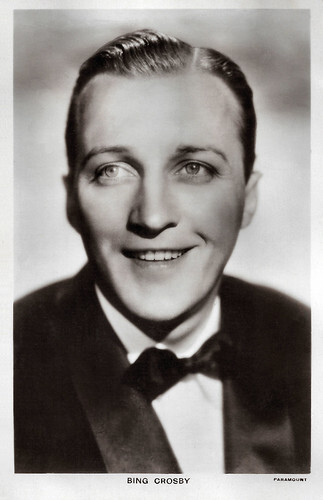
British postcard in the Picturegoer Series, London, no. 768. Photo: Paramount.
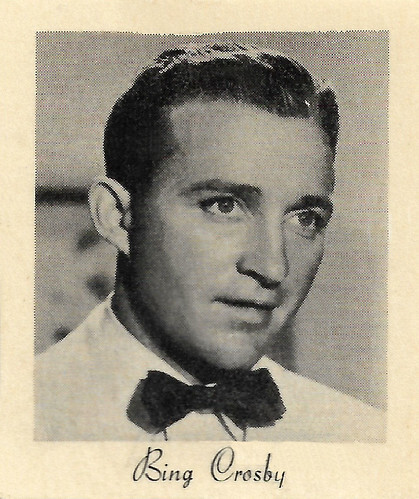
Dutch chewing card by Smith's Chewing Sweets Ltd., Rotterdam, no. 7 for 48. This card is a gift from Loek Coenraad from his mother's legacy.
Road to...
Bing Crosby's relaxed, low-key style carried over into the series of 'Road to...' comedies he made with pal Bob Hope and Dorothy Lamour . The series consists of Road to Singapore (Victor Schertzinger, 1940), Road to Zanzibar (Victor Schertzinger, 1941), Road to Morocco (David Butler, 1942), Road to Utopia (Hal Walker, 1946), Road to Rio (Norman Z. McLeod, 1947), Road to Bali (Hal Walker, 1952), and The Road to Hong Kong (Norman Panama, 1962).
He won the Best Actor Oscar for playing the easygoing priest Father Chuck O'Malley in Going My Way (Leo McCarey, 1944), and was nominated for his reprise of the role in The Bells of St. Mary's (Leo McCarey, 1945) opposite Ingrid Bergman the next year, becoming the first of six actors to be nominated twice for playing the same character.
He showed that he was indeed an actor as well as a performer when he played an alcoholic actor down on his luck opposite Grace Kelly in The Country Girl (George Seaton, 1954). Stagecoach (Gordon Douglas, 1966) with Ann-Margret , was his last major film. Though it did not get good reviews, his performance as the drunken doctor was praised.
Playing golf was what he liked to do best. Bing Crosby died at age 74 playing golf at a course outside Madrid, Spain, after completing a tour of England that had included a sold-out engagement at the London Palladium. On 13 October 1977, the day before Crosby's death, independent producer Lew Grade announced that he was reuniting Crosby, Bob Hope , and Dorothy Lamour onscreen for the film Road to the Fountain of Youth, ending several years of speculation as to whether the trio would reunite professionally or not.
Bing Crosby was married twice: first, he married film actress Dixie Lee. They had four children and divorced in 1952. He married his second wife, Kathryn Grant, in 1957. They had three children and remained together till his death in 1977. His eldest son Gary Crosby criticised Bing's violent ways as a father in the biography 'Going My Own Way' (1983) which was touted as a "Daddy Dearest". Bing's children from his second marriage, including daughter and actress Mary Crosby, praised him as a kind and loving father in later life. Phil Crosby, Jr., Bing's grandson, formed a jazz quartet in the Los Angeles area and is bringing a semi-resurgence of interest in Bing and his music.
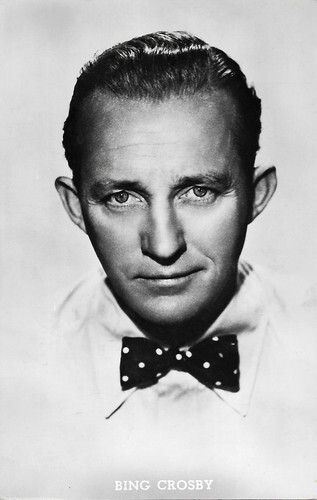
Belgian postcard, no. 850. Photo: Paramount Pictures.
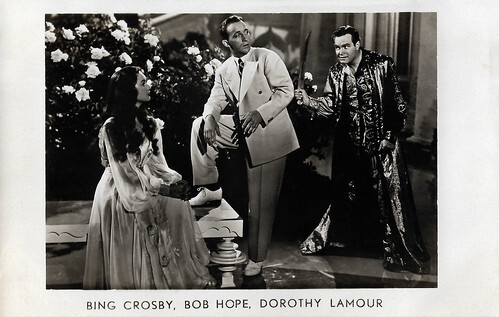
Dutch postcard, no. 249. Photo: Paramount Pictures / M.P.E.A. Bing Crosby, Bob Hope and Dorothy Lamour in Road to Morocco (David Butler, 1942).
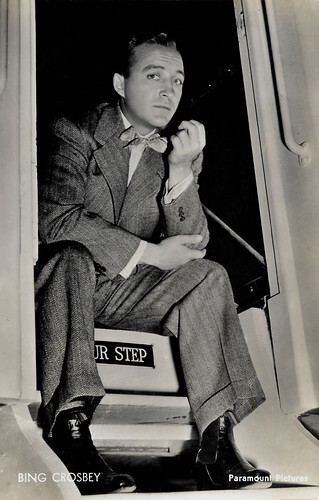
Dutch postcard by J.S.A., no. 740 / 101. Photo: Paramount Pictures.
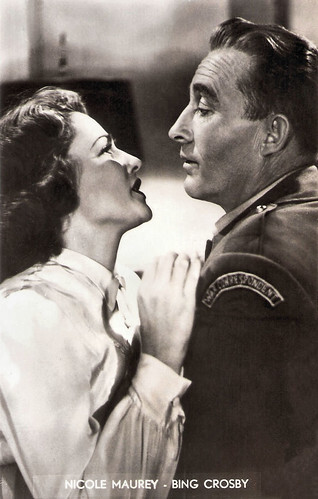
Vintage postcard. Photo: Paramount. Nicole Maurey and Bing Crosby in Little Boy Lost (George Seaton, 1953).
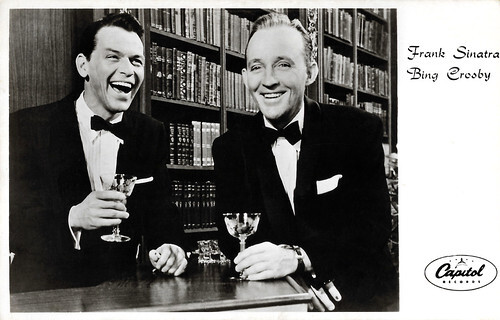
Dutch postcard by Editions Altona, Amsterdam / Gebr. Spanjersberg, Rotterdam, no. 5135. Photo: Capitol Records. Frank Sinatra and Bing Crosby in High Society (Charles Walters, 1956).
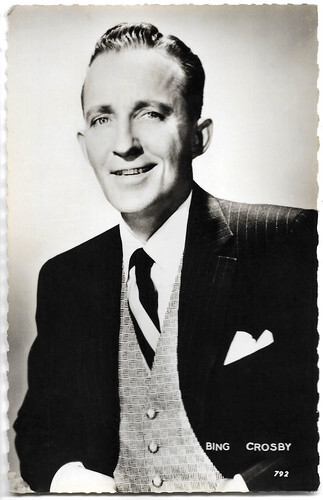
French postcard, by Editions P.I., offered by Les Carbones Korès "Carboplane", no. 792. Photo: Paramount Pictures, 1954.
Sources: (IMDb), Wikipedia, and .

Uruguayan postcard by CF. Photo: Paramount.

British postcard, sent by mail in 1935. Photo: Paramount Pictures.

British postcard by Art Photo, no. 169. Mary Carlisle and Bing Crosby in Doctor Rhythm (Frank Tuttle, 1938).

Dutch postcard by Takken, no. 3015. Photo: MGM. Bing Crosby and Grace Kelly in High Society (Charles Walters, 1956).

American Candid Color Card, Beverley Hills, Calif., no. A 39. Photo: Bud Fraker / Paramount. Caption: Bing Crosby, Paramount's great star, and husband of Dixie Crosby, and their four sons: Gary Evan, born June 25, 1933; twins Phillip Land and Dennis Michael, born July 13, 1934, and Lindsay Harry, born Jan. 5, 1938.
White Christmas
Bing Crosby was born Harry Lillis Crosby, Jr. in Tacoma, Washington, in 1903. He was the fourth of seven children of Catherine Helen "Kate" (Harrigan) and Harry Lowe Crosby, a brewery bookkeeper.
Crosby studied law at Gonzaga University in Spokane but was more interested in playing the drums and singing with a local band. Bing and the band's piano player, Al Rinker, left Spokane for Los Angeles in 1925.
In the early 1930s, Bing's brother Everett sent a record of Bing singing 'I Surrender, Dear' to the president of CBS. His live performances from New York were carried over the national radio network for 20 consecutive weeks in 1932.
His radio success led Paramount Pictures to include him in the musical comedy The Big Broadcast (Frank Tuttle, 1932), a film featuring radio favourites. His songs about not needing a bundle of money to make life happy had the right message for the decade of the Great Depression. He was the star of such radio shows as 'Kraft Music Hall' (1935-1946), 'Philco Radio Time' (1946-1949), 'The Bing Crosby Chesterfield Show' (1949-1952), and 'The Bing Crosby Show' (1954-1956).
His song 'White Christmas' became the bestselling single for more than 50 years until overtaken in 1997 by 'Candle in the Wind', Elton John 's tribute to the late Princess Diana.

American postcard by Brunswick. Photo: Paramount.

Dutch postcard, no. 599, sent by mail in 1934. Photo: Metro-Goldwyn-Mayer. Marion Davies and Bing Crosby in Going Hollywood (Raoul Walsh, 1933).

British card. Photo: Paramount. Bing Crosby as J. Paul Jones in Here Is My Heart (Frank Tuttle, 1934).

British postcard in the Picturegoer Series, London, no. 768. Photo: Paramount.

Dutch chewing card by Smith's Chewing Sweets Ltd., Rotterdam, no. 7 for 48. This card is a gift from Loek Coenraad from his mother's legacy.
Road to...
Bing Crosby's relaxed, low-key style carried over into the series of 'Road to...' comedies he made with pal Bob Hope and Dorothy Lamour . The series consists of Road to Singapore (Victor Schertzinger, 1940), Road to Zanzibar (Victor Schertzinger, 1941), Road to Morocco (David Butler, 1942), Road to Utopia (Hal Walker, 1946), Road to Rio (Norman Z. McLeod, 1947), Road to Bali (Hal Walker, 1952), and The Road to Hong Kong (Norman Panama, 1962).
He won the Best Actor Oscar for playing the easygoing priest Father Chuck O'Malley in Going My Way (Leo McCarey, 1944), and was nominated for his reprise of the role in The Bells of St. Mary's (Leo McCarey, 1945) opposite Ingrid Bergman the next year, becoming the first of six actors to be nominated twice for playing the same character.
He showed that he was indeed an actor as well as a performer when he played an alcoholic actor down on his luck opposite Grace Kelly in The Country Girl (George Seaton, 1954). Stagecoach (Gordon Douglas, 1966) with Ann-Margret , was his last major film. Though it did not get good reviews, his performance as the drunken doctor was praised.
Playing golf was what he liked to do best. Bing Crosby died at age 74 playing golf at a course outside Madrid, Spain, after completing a tour of England that had included a sold-out engagement at the London Palladium. On 13 October 1977, the day before Crosby's death, independent producer Lew Grade announced that he was reuniting Crosby, Bob Hope , and Dorothy Lamour onscreen for the film Road to the Fountain of Youth, ending several years of speculation as to whether the trio would reunite professionally or not.
Bing Crosby was married twice: first, he married film actress Dixie Lee. They had four children and divorced in 1952. He married his second wife, Kathryn Grant, in 1957. They had three children and remained together till his death in 1977. His eldest son Gary Crosby criticised Bing's violent ways as a father in the biography 'Going My Own Way' (1983) which was touted as a "Daddy Dearest". Bing's children from his second marriage, including daughter and actress Mary Crosby, praised him as a kind and loving father in later life. Phil Crosby, Jr., Bing's grandson, formed a jazz quartet in the Los Angeles area and is bringing a semi-resurgence of interest in Bing and his music.

Belgian postcard, no. 850. Photo: Paramount Pictures.

Dutch postcard, no. 249. Photo: Paramount Pictures / M.P.E.A. Bing Crosby, Bob Hope and Dorothy Lamour in Road to Morocco (David Butler, 1942).

Dutch postcard by J.S.A., no. 740 / 101. Photo: Paramount Pictures.

Vintage postcard. Photo: Paramount. Nicole Maurey and Bing Crosby in Little Boy Lost (George Seaton, 1953).

Dutch postcard by Editions Altona, Amsterdam / Gebr. Spanjersberg, Rotterdam, no. 5135. Photo: Capitol Records. Frank Sinatra and Bing Crosby in High Society (Charles Walters, 1956).

French postcard, by Editions P.I., offered by Les Carbones Korès "Carboplane", no. 792. Photo: Paramount Pictures, 1954.
Sources: (IMDb), Wikipedia, and .
Published on November 23, 2023 22:00
November 22, 2023
William Collier Jr.
American film actor William Collier Jr. (1902–1987) or Buster Collier Jr. acted from 1916 in almost 90 films. Opposite female stars such as Olive Thomas, Shirley Mason, and Greta Nissen, Collier was a popular male lead. He starred in The Wanderer (Raoul Walsh, 1925), inspired by the Old Testament tale of the prodigal son. Collier easily made the passage to sound film but in 1937 he started as a film producer in the UK. In the late 1940s, he returned to the US and became a TV producer.
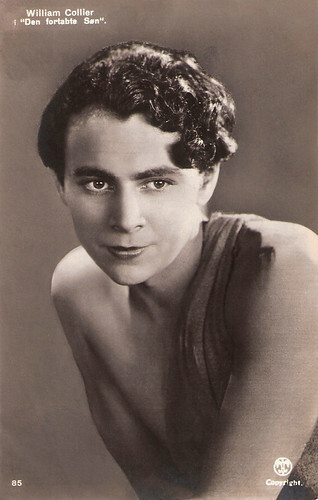
Danish postcard by Alex Vincent's Kunstforlag, Kobenhavn (Copenhagen), no. 85. Photo: William Collier Jr. in The Wanderer (Raoul Walsh, 1925), an adaptation of the Biblical story of the Prodigal Son.
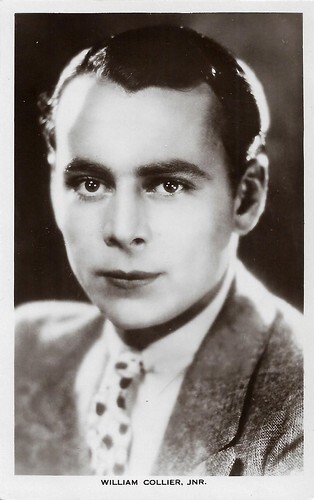
British postcard in the Picturegoer Series, London, no. 305A.
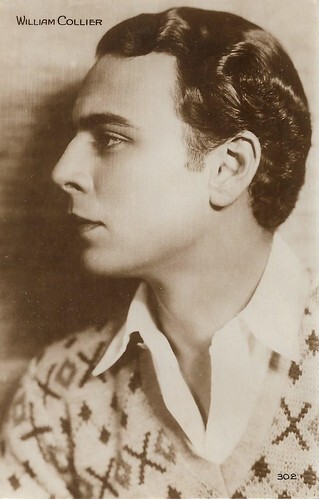
French postcard by Cinémagazine-Edition, Paris, no. 302.
An actor in youthful leading roles
Charles F. Gall Junior was born in in 1902 in New York City as the son of the theatre actress Paula Marr and the theatre manager Charles F. Gall.
He appeared on stage for the first time at the age of seven. After his parents divorced, his mother married again: to the well-known actor William Collier Senior (1864-1944). He adopted Charles Gall Jr. and renamed his stepson William Collier Junior in 1914.
Having already gained some experience on the stage, Collier made his first silent film, The Bugle Call, in 1916 at the age of 14. This was the beginning of a very successful career as a silent film actor in Hollywood.
Especially in the 1920s, Collier achieved temporary popularity as an actor in youthful leading roles, in particular in Raoul Walsh's epic The Wanderer (1925), based on the Biblical tale of the prodigal son, who longs for the city and squanders his inheritance on gambling and on a seductive priestess of Ishtar, Tisha ( Greta Nissen ). She kicks him out when his money has gone, but God punishes both her and the city. The young man goes from riches to rags but is eventually welcomed back by his father.
Sadly, only an incomplete of the film survives. On the whole, most of Collier's silent films are lost today. Collier was a popular male lead in the 1920s, or antagonist to the male lead, opposite female stars such as Olive Thomas, Louise Lorraine, Madge Bellamy , Betty Compson , and in particular Irene Rich , Shirley Mason and Greta Nissen , with whom he did several films.
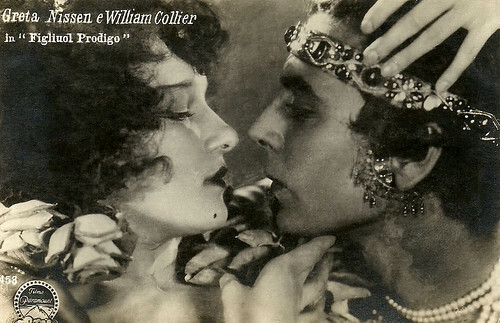
Italian postcard by Casa Editrice Ballerini & Fratini, Firenze (Florence), no. 458. Photo: SAI Films Paramount, Roma. Greta Nissen and William Collier in The Wanderer (Raoul Walsh, 1925), released in Italy as Il figliuol prodigo [The prodigal son]. Collection: Didier Hanson.
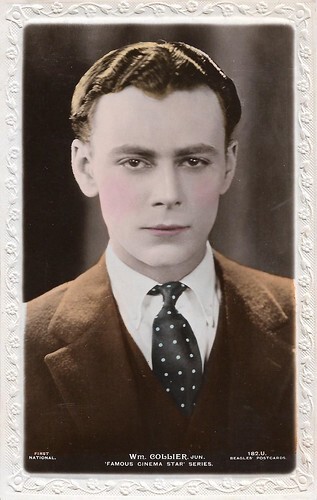
British postcard in the Famous Cinema Film Star series by Beagles, no. 180.U. Photo: First National.
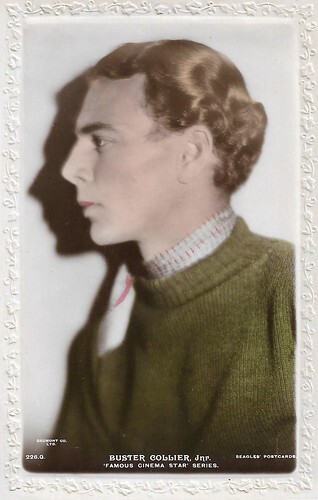
British postcard in the Famous Cinema Film Star series by Beagles, no. 226.G. Photo: Gaumont Co. Ltd.
Gangster classic
William Collier Jr. mastered the leap into the talkies at the end of the 1920s without major problems. In 1931 he played his most famous film roles today.
In Mervyn LeRoy's gangster classic Little Caesar (1931) he played the gangster Tony Passa alongside Edward G. Robinson , and in the Western epic Cimarron (1931) - which won the Oscar for Best Picture of the Year - he took on an important supporting role as a bandit.
Also in 1931, he played the young sympathiser in King Vidor's socially critical drama Street Scene. Soon after, however, his popularity waned and he retired from acting in 1935 after the film The People's Enemy by Crane Wilbur. He had appeared in a total of 89 films over a 19-year period.
Collier then worked as a producer of films and plays, first in the United States, and then in England from 1937 to the late 1940s. He returned to the USA in the 1950s and was responsible for several television series as a producer.
William Collier was married to Marie Stevens from 1934 until her death in 1981; they had one child. He died of arteriosclerosis in San Francisco in 1987, a week before his 85th birthday. He has a star on the Hollywood Walk of Fame for his film work.
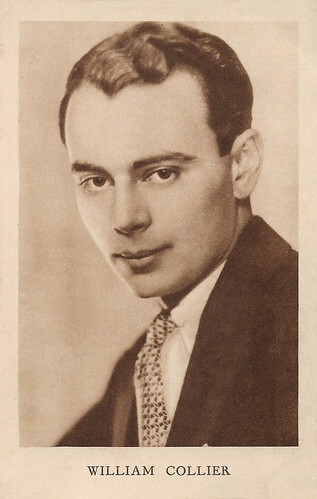
Belgian postcard. by Ed. Weekblad Cinéma, Antwerp.
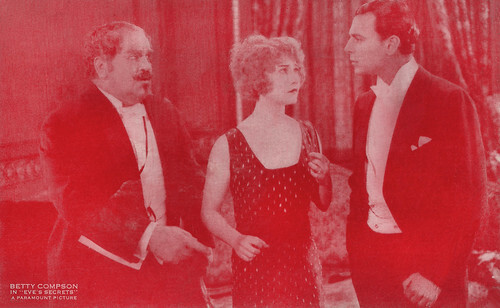
American Arcade card by Exhibit Supply Co., Chicago, Ill. Photo: Paramount Pictures. Betty Compson , Lionel Belmore and William Collier Jr in Eve's Secrets (Clarence G. Badger, 1925).
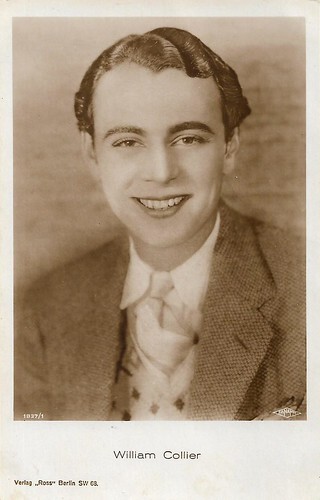
German postcard by Ross Verlag, Berlin, no. 1837/1, 1927-1928. Photo: Fanamet.
Sources: Wikipedia (German and English) and .

Danish postcard by Alex Vincent's Kunstforlag, Kobenhavn (Copenhagen), no. 85. Photo: William Collier Jr. in The Wanderer (Raoul Walsh, 1925), an adaptation of the Biblical story of the Prodigal Son.

British postcard in the Picturegoer Series, London, no. 305A.

French postcard by Cinémagazine-Edition, Paris, no. 302.
An actor in youthful leading roles
Charles F. Gall Junior was born in in 1902 in New York City as the son of the theatre actress Paula Marr and the theatre manager Charles F. Gall.
He appeared on stage for the first time at the age of seven. After his parents divorced, his mother married again: to the well-known actor William Collier Senior (1864-1944). He adopted Charles Gall Jr. and renamed his stepson William Collier Junior in 1914.
Having already gained some experience on the stage, Collier made his first silent film, The Bugle Call, in 1916 at the age of 14. This was the beginning of a very successful career as a silent film actor in Hollywood.
Especially in the 1920s, Collier achieved temporary popularity as an actor in youthful leading roles, in particular in Raoul Walsh's epic The Wanderer (1925), based on the Biblical tale of the prodigal son, who longs for the city and squanders his inheritance on gambling and on a seductive priestess of Ishtar, Tisha ( Greta Nissen ). She kicks him out when his money has gone, but God punishes both her and the city. The young man goes from riches to rags but is eventually welcomed back by his father.
Sadly, only an incomplete of the film survives. On the whole, most of Collier's silent films are lost today. Collier was a popular male lead in the 1920s, or antagonist to the male lead, opposite female stars such as Olive Thomas, Louise Lorraine, Madge Bellamy , Betty Compson , and in particular Irene Rich , Shirley Mason and Greta Nissen , with whom he did several films.

Italian postcard by Casa Editrice Ballerini & Fratini, Firenze (Florence), no. 458. Photo: SAI Films Paramount, Roma. Greta Nissen and William Collier in The Wanderer (Raoul Walsh, 1925), released in Italy as Il figliuol prodigo [The prodigal son]. Collection: Didier Hanson.

British postcard in the Famous Cinema Film Star series by Beagles, no. 180.U. Photo: First National.

British postcard in the Famous Cinema Film Star series by Beagles, no. 226.G. Photo: Gaumont Co. Ltd.
Gangster classic
William Collier Jr. mastered the leap into the talkies at the end of the 1920s without major problems. In 1931 he played his most famous film roles today.
In Mervyn LeRoy's gangster classic Little Caesar (1931) he played the gangster Tony Passa alongside Edward G. Robinson , and in the Western epic Cimarron (1931) - which won the Oscar for Best Picture of the Year - he took on an important supporting role as a bandit.
Also in 1931, he played the young sympathiser in King Vidor's socially critical drama Street Scene. Soon after, however, his popularity waned and he retired from acting in 1935 after the film The People's Enemy by Crane Wilbur. He had appeared in a total of 89 films over a 19-year period.
Collier then worked as a producer of films and plays, first in the United States, and then in England from 1937 to the late 1940s. He returned to the USA in the 1950s and was responsible for several television series as a producer.
William Collier was married to Marie Stevens from 1934 until her death in 1981; they had one child. He died of arteriosclerosis in San Francisco in 1987, a week before his 85th birthday. He has a star on the Hollywood Walk of Fame for his film work.

Belgian postcard. by Ed. Weekblad Cinéma, Antwerp.

American Arcade card by Exhibit Supply Co., Chicago, Ill. Photo: Paramount Pictures. Betty Compson , Lionel Belmore and William Collier Jr in Eve's Secrets (Clarence G. Badger, 1925).

German postcard by Ross Verlag, Berlin, no. 1837/1, 1927-1928. Photo: Fanamet.
Sources: Wikipedia (German and English) and .
Published on November 22, 2023 22:00
November 21, 2023
L'esclave de Phidias (1917)
In the Pathé production L'esclave de Phidias/The Slave of Phydias (Léonce Perret, 1917), Suzanne Delvé starred as the slave Callyce in love with her master, the Athenian sculptor Phidias, played by the future director Luitz-Morat. Ivo Blom collected a series of six 'cromos', Spanish collector's cards in chocolate boxes, of the film.
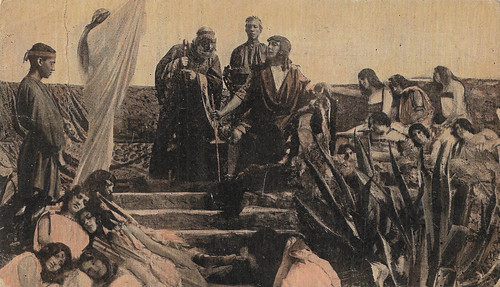
Spanish cromo by Chocolate Salas-Sabadell, no. 2 of 6 cards. Photo: Gaumont. L'esclave de Phidias/The Slave of Phydias (Léonce Perret, 1917), starring Luitz-Morat as the Greek sculptor Phidias, here selecting a new model for his upcoming statue. The Spanish release title was La esclava de Fidias.
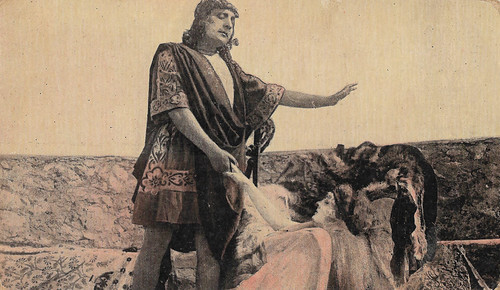
Spanish cromo by Chocolate Salas-Sabadell, no. 2 of 6 cards. Photo: Gaumont. Luitz-Morat as the Greek sculptor Phidias and Suzanne Delvé as the slave Callyce in L'esclave de Phidias (Léonce Perret, 1917).
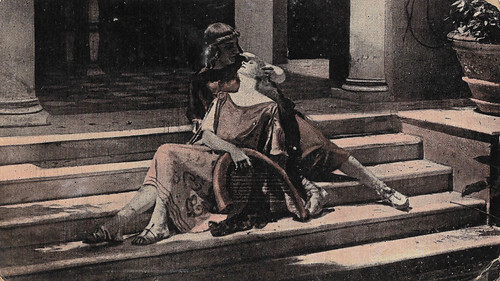
Spanish cromo by Chocolate Salas-Sabadell, no. 3 of 6 cards. Photo: Gaumont. Luitz-Morat as the Greek sculptor Phidias and Suzanne Delvé as the slave Callyce in L'esclave de Phidias (Léonce Perret, 1917).
A long poetic composition for music and images
The flip sides of the Spanish collector's cards contain the plot of L'esclave de Phidias/The Slave of Phydias (Léonce Perret, 1917). The famous Athenian sculptor Phidias has been commissioned to sculpt a statue of Venus. Dissatisfied with his models, he goes to a slave market where he discovers the beautiful slave Callyce. She becomes his model.
Phidias has a jealous lover, the courtesan Quinta. She discovers the love between Phidias and his slave and takes revenge. She has Callyce whipped, while she also steals the gold destined to cover the statue of Venus. Phidias is accused of theft, caught, not believed and exiled for life. Phidias flees by boat together with his beloved Callyce.
In 2016, L'esclave de Phidias/The Slave of Phydias was presented at Il Cinema Ritrovato in Bologna. British film historian Maria Wyke wrote in the festival catalogue: "Perret creates here another of his exquisite pictorial melodramas. Advertised by Gaumont as an 'ancient poem', the film is a long poetic composition for music and images. The studied composition and depth of field of the tableaux recall the seductive antiquity depicted in Alma-Tadema's paintings, bringing it to life.
Much of the film is shot on location on the coast of southern France, among the cedars and cypresses of an elegant neoclassical villa. The characters appear to us streaked with light, reflected in shimmering pools of water, silhouetted against a shimmering sea in images of great emotional intensity. This is not a grandiose historical film about Phidias and the colossal works he created to celebrate the Athenian state. What matters is not the sculptor's creativity but his model, the poor slave girl who gives the film its title. While Phidias attempts to sculpt a statue of the goddess of love that is destined to remain off-screen and unfinished for the duration of the film, the young slave girl arouses true love passion in the artist with the beauty of her complexion and above all the sound of her lyre.
At the end of the film, the lovers face oblivion, forced to say goodbye to the peace of a 'land of love and beauty' that is both ancient Greece and contemporary France. The themes of suffering, loss and exile are in tune with the climate of the First World War, during which the film was shot. At the premiere, which took place at the Gaumont Palace in early 1917, Eugène Poncin conducted his score for soloists, choir and large orchestra composed especially to accompany Perret's 'aesthetic symphony' dedicated to a hapless love against the backdrop of a tragic Hellas."
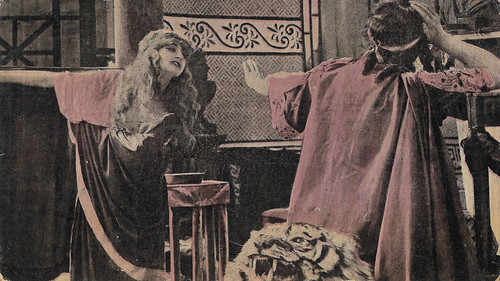
Spanish cromo by Chocolate Salas-Sabadell, no. 4 of 6 cards. Photo: Gaumont. Luitz-Morat as the Greek sculptor Phidias and Suzanne Delvé as the slave Callyce in L'esclave de Phidias (Léonce Perret, 1917).
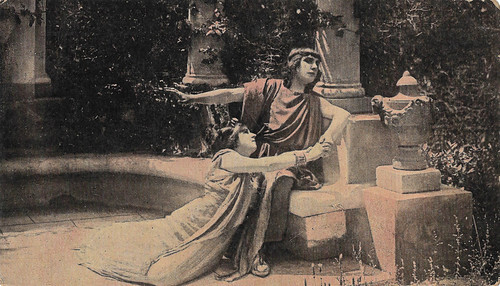
Spanish cromo by Chocolate Salas-Sabadell, no. 5 of 6 cards. Photo: Gaumont. Luitz-Morat as the Greek sculptor Phidias and Madeleine Ramey as the courtesan Quinta, rejected by Phidias, in L'esclave de Phidias (Léonce Perret, 1917).
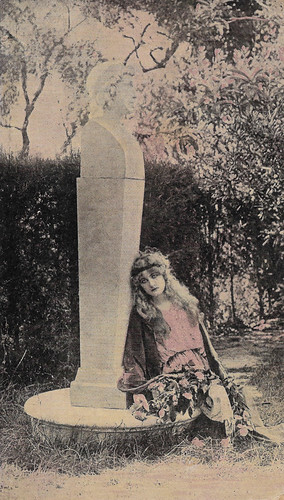
Spanish cromo by Chocolate Salas-Sabadell, no. 6 of 6 cards. Photo: Gaumont. Suzanne Delvé as the slave Callyce dreaming of her beloved Phidias in L'esclave de Phidias/The Slave of Phydias (Léonce Perret, 1917).
Sources: Maria Wyke (catalogue Cinema Ritrovato, Bologna, 2016), IMDb and the cards.

Spanish cromo by Chocolate Salas-Sabadell, no. 2 of 6 cards. Photo: Gaumont. L'esclave de Phidias/The Slave of Phydias (Léonce Perret, 1917), starring Luitz-Morat as the Greek sculptor Phidias, here selecting a new model for his upcoming statue. The Spanish release title was La esclava de Fidias.

Spanish cromo by Chocolate Salas-Sabadell, no. 2 of 6 cards. Photo: Gaumont. Luitz-Morat as the Greek sculptor Phidias and Suzanne Delvé as the slave Callyce in L'esclave de Phidias (Léonce Perret, 1917).

Spanish cromo by Chocolate Salas-Sabadell, no. 3 of 6 cards. Photo: Gaumont. Luitz-Morat as the Greek sculptor Phidias and Suzanne Delvé as the slave Callyce in L'esclave de Phidias (Léonce Perret, 1917).
A long poetic composition for music and images
The flip sides of the Spanish collector's cards contain the plot of L'esclave de Phidias/The Slave of Phydias (Léonce Perret, 1917). The famous Athenian sculptor Phidias has been commissioned to sculpt a statue of Venus. Dissatisfied with his models, he goes to a slave market where he discovers the beautiful slave Callyce. She becomes his model.
Phidias has a jealous lover, the courtesan Quinta. She discovers the love between Phidias and his slave and takes revenge. She has Callyce whipped, while she also steals the gold destined to cover the statue of Venus. Phidias is accused of theft, caught, not believed and exiled for life. Phidias flees by boat together with his beloved Callyce.
In 2016, L'esclave de Phidias/The Slave of Phydias was presented at Il Cinema Ritrovato in Bologna. British film historian Maria Wyke wrote in the festival catalogue: "Perret creates here another of his exquisite pictorial melodramas. Advertised by Gaumont as an 'ancient poem', the film is a long poetic composition for music and images. The studied composition and depth of field of the tableaux recall the seductive antiquity depicted in Alma-Tadema's paintings, bringing it to life.
Much of the film is shot on location on the coast of southern France, among the cedars and cypresses of an elegant neoclassical villa. The characters appear to us streaked with light, reflected in shimmering pools of water, silhouetted against a shimmering sea in images of great emotional intensity. This is not a grandiose historical film about Phidias and the colossal works he created to celebrate the Athenian state. What matters is not the sculptor's creativity but his model, the poor slave girl who gives the film its title. While Phidias attempts to sculpt a statue of the goddess of love that is destined to remain off-screen and unfinished for the duration of the film, the young slave girl arouses true love passion in the artist with the beauty of her complexion and above all the sound of her lyre.
At the end of the film, the lovers face oblivion, forced to say goodbye to the peace of a 'land of love and beauty' that is both ancient Greece and contemporary France. The themes of suffering, loss and exile are in tune with the climate of the First World War, during which the film was shot. At the premiere, which took place at the Gaumont Palace in early 1917, Eugène Poncin conducted his score for soloists, choir and large orchestra composed especially to accompany Perret's 'aesthetic symphony' dedicated to a hapless love against the backdrop of a tragic Hellas."

Spanish cromo by Chocolate Salas-Sabadell, no. 4 of 6 cards. Photo: Gaumont. Luitz-Morat as the Greek sculptor Phidias and Suzanne Delvé as the slave Callyce in L'esclave de Phidias (Léonce Perret, 1917).

Spanish cromo by Chocolate Salas-Sabadell, no. 5 of 6 cards. Photo: Gaumont. Luitz-Morat as the Greek sculptor Phidias and Madeleine Ramey as the courtesan Quinta, rejected by Phidias, in L'esclave de Phidias (Léonce Perret, 1917).

Spanish cromo by Chocolate Salas-Sabadell, no. 6 of 6 cards. Photo: Gaumont. Suzanne Delvé as the slave Callyce dreaming of her beloved Phidias in L'esclave de Phidias/The Slave of Phydias (Léonce Perret, 1917).
Sources: Maria Wyke (catalogue Cinema Ritrovato, Bologna, 2016), IMDb and the cards.
Published on November 21, 2023 22:00
November 20, 2023
William Desmond
William Desmond (1878–1949) was an American actor, who appeared in 205 films between 1915 and 1948. He was nicknamed "The King of the Silent Serials" and acted in numerous Westerns.
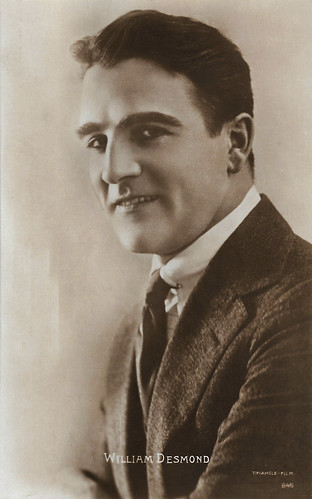
Swedish postcard by Förlag Nordisk Konst, Stockholm, no. 845. Photo: Triangle-Film.
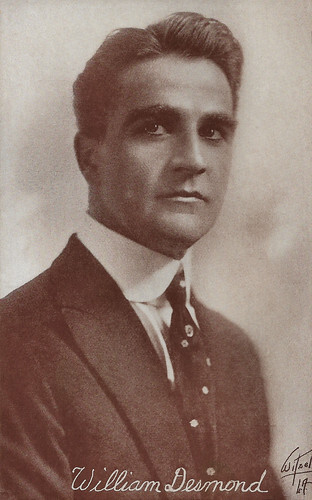
American Arcade postcard. Photo: Witzel, L.A.
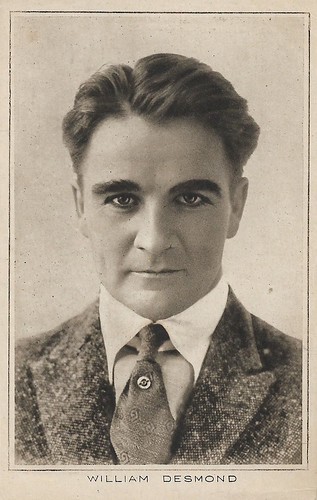
British postcard by 'Pictures' Portrait Gallery, London, no. 22.
Six feet tall and good-looking
William Desmond was born William Desmond Mannion in 1878 in Dublin, Ireland, according to Italian Wikipedia . "Not so!", writes Chuck Anderson at B-Western site The Old Corral : "A Desmond family member advised that he was born January 23, 1878, in Horseheads, Chemung County, New York. His father Richard worked for the railroad and when the 1880 census was taken, the Mannion family had moved to Salamanca, Cattaraugus County, New York, which is about sixty miles south of Buffalo. His father hailed from Ireland and his mother was born in New York and William was their first child."
He changed his name to William Desmond when he landed on the theatrical stage. He started out in vaudeville and the legitimate stage. Most of Desmond's early stage and vaudeville work was tied to noted theatrical producer Oliver Morosco. During this period, his Morosco credits include the brief 1906 run of 'The Judge and the Jury' in New York City as well as a multi-year stay at Morosoco's Burbank theatre in Los Angeles. He also spent time appearing with the Los Angeles Opera House. Desmond's other theatrical credits included 'Ben Hur', 'Alias Jimmy Valentine', 'If I Were King', 'Raffles', 'Sign of the Cross', and 'Romeo and Juliet'.
He signed with the J. C. Williamson organisation and toured Australia during 1910-1913. With him was his wife Lilian Lamson, the older sister of Gertrude Lamson a.k.a. screen actress Nance O'Neill. But tragedy struck. Lilian was injured in Australia and became an invalid, passing away at age 39 in 1917 at the Desmond home in Hollywood.
After his return from Australia, Desmond re-teamed with Oliver Morosco for more plays. For a couple of years, he played various cities in the U.S. and Canada in 'The Bird of Paradise'. Lenore Ulrich was his leading lady. Morosco liked the chemistry between Desmond and Ulrich and he paired them in the film Kilmeny (Oscar Apfel, 1915). It was produced by the Oliver Morosco Photoplay Company, which Morosco did in collaboration with Hobart Bosworth and the film was distributed by Paramount Pictures.
Six feet tall (183 cm) and good-looking, Desmond appeared in more dramatic parts, in such other films as Peer Gynt (Oscar Apfel, Raoul Walsh, 1915). Desmond connected with film pioneer Thomas H. Ince for films churned out by Ince's NYMP company (New York Motion Picture) and distributed by Triangle. His first film for Ince was the drama Peggy (Thomas Ince, 1916) with Desmond as a minister in love with Billie Burke . He appeared with Gloria Swanson in Society for Sale (Frank Borzage, 1918). Desmond signed with Jesse D. Hampton for a series of Westerns and action serials which were released through Exhibitors Mutual, Robertson-Cole, and Pathé. Actor-director Joseph Franz directed such Westerns as Bare-fisted Gallagher (1919) and A Broadway Cowboy (1920). In 1919, he married his co-star, Mary McIvor, with whom he had two daughters. Desmond became a major Western star.
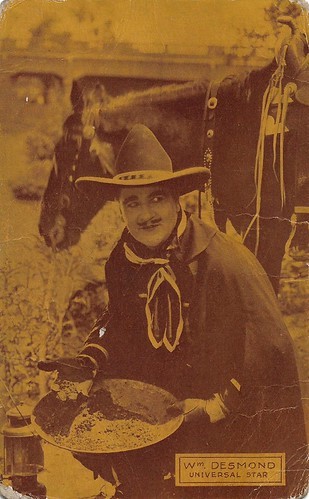
American Arcade card. Caption: William Desmond, Universal Star.
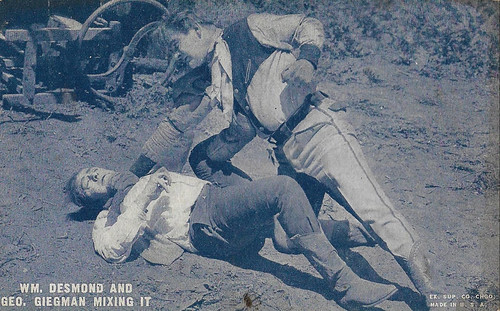
American Arcade card by Exhibit Supply Co., Chicago. Caption: William Desmond and Geo. Giegman Mixing It.
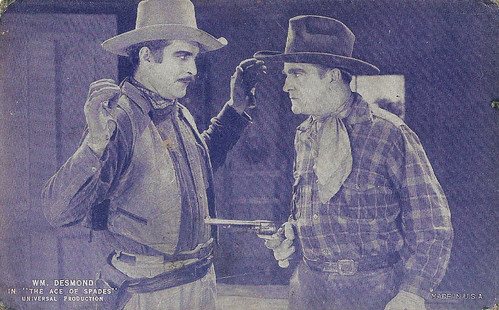
American Arcade card. Photo: Universal Production. William Desmond in The Ace of Spades (Henry MacRae, 1925).
The King of the Silent Serials
William Desmond even created his own production company for another cowboy adventure, Fightin'Mad (Joseph Franz, 1921), which was distributed by Metro, a forerunner of MGM. His next stop was Universal Pictures and during the years 1922-1928, he reached his peak as a Western/action hero and became known as "the King of the Silent Serials".
He starred in robust serials such as Perils of the Yukon (Jay Marchant, J. P. McGowan, Perry N. Vekroff, 1922) with Laura La Plante , The Riddle Rider (William James Craft, 1924) with Eileen Sedgwick, and The Vanishing Rider (Ray Taylor, 1928), all for Universal.
AllMovie : "He did his own stunts, and hardly a week went by in the 1920s that Desmond didn't give the newspapers a story about how he'd once again cheated death in the line of duty." Desmond was not tied exclusively to Universal but under a mix of contract deals.
During those years, Desmond and his wife Mary continued to tour with their stage act, and Desmond also co-starred with Helen Holmes in some non-Westerns for independent producer Jesse J. Goldburg. When the sound era began William Desmond was almost 50 years old and his leading man days were over. He was now relegated to supporting roles, but he continued making films into the 1940s. He had bit roles in such memorable films as Phantom Lady (Robert Siodmak, 1944) with Ella Raines and The Egg and I (Chester Erskine, 1947) starring Claudette Colbert .
While he and his wife Mary headlined the Barnett Bros. Circus in 1938, he suffered a stroke and was hospitalised. Mary died in 1941. William lived with his daughter Mary Jo during the last year of his life. In 1949, William Desmond died at age 71 of a heart attack in Los Angeles, California. His cremated remains are stored in the vault at the Chapel of the Pines Crematory, Los Angeles. Mary and William had two daughters - Mary Joanna (born 1920 and William S. Hart , a co-star of Mary McIvor during the 1910s, was her godfather) and Elizabeth Terry (1932).
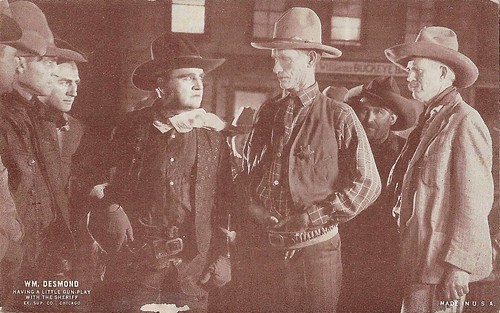
American Arcade card by Exhibit Supply Co., Chicago. Caption: William Desmond, Having a Little Gun-play with the Sheriff.
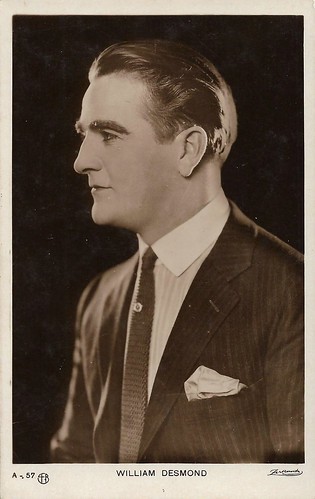
Spanish postcard by EFB (Editorial Fotografica, Barcelona), no. A-57. Photo: Zerkowitz.
Sources: Chuck Anderson (The Old Corral), AllMovie, Wikipedia (English and Italian) and .

Swedish postcard by Förlag Nordisk Konst, Stockholm, no. 845. Photo: Triangle-Film.

American Arcade postcard. Photo: Witzel, L.A.

British postcard by 'Pictures' Portrait Gallery, London, no. 22.
Six feet tall and good-looking
William Desmond was born William Desmond Mannion in 1878 in Dublin, Ireland, according to Italian Wikipedia . "Not so!", writes Chuck Anderson at B-Western site The Old Corral : "A Desmond family member advised that he was born January 23, 1878, in Horseheads, Chemung County, New York. His father Richard worked for the railroad and when the 1880 census was taken, the Mannion family had moved to Salamanca, Cattaraugus County, New York, which is about sixty miles south of Buffalo. His father hailed from Ireland and his mother was born in New York and William was their first child."
He changed his name to William Desmond when he landed on the theatrical stage. He started out in vaudeville and the legitimate stage. Most of Desmond's early stage and vaudeville work was tied to noted theatrical producer Oliver Morosco. During this period, his Morosco credits include the brief 1906 run of 'The Judge and the Jury' in New York City as well as a multi-year stay at Morosoco's Burbank theatre in Los Angeles. He also spent time appearing with the Los Angeles Opera House. Desmond's other theatrical credits included 'Ben Hur', 'Alias Jimmy Valentine', 'If I Were King', 'Raffles', 'Sign of the Cross', and 'Romeo and Juliet'.
He signed with the J. C. Williamson organisation and toured Australia during 1910-1913. With him was his wife Lilian Lamson, the older sister of Gertrude Lamson a.k.a. screen actress Nance O'Neill. But tragedy struck. Lilian was injured in Australia and became an invalid, passing away at age 39 in 1917 at the Desmond home in Hollywood.
After his return from Australia, Desmond re-teamed with Oliver Morosco for more plays. For a couple of years, he played various cities in the U.S. and Canada in 'The Bird of Paradise'. Lenore Ulrich was his leading lady. Morosco liked the chemistry between Desmond and Ulrich and he paired them in the film Kilmeny (Oscar Apfel, 1915). It was produced by the Oliver Morosco Photoplay Company, which Morosco did in collaboration with Hobart Bosworth and the film was distributed by Paramount Pictures.
Six feet tall (183 cm) and good-looking, Desmond appeared in more dramatic parts, in such other films as Peer Gynt (Oscar Apfel, Raoul Walsh, 1915). Desmond connected with film pioneer Thomas H. Ince for films churned out by Ince's NYMP company (New York Motion Picture) and distributed by Triangle. His first film for Ince was the drama Peggy (Thomas Ince, 1916) with Desmond as a minister in love with Billie Burke . He appeared with Gloria Swanson in Society for Sale (Frank Borzage, 1918). Desmond signed with Jesse D. Hampton for a series of Westerns and action serials which were released through Exhibitors Mutual, Robertson-Cole, and Pathé. Actor-director Joseph Franz directed such Westerns as Bare-fisted Gallagher (1919) and A Broadway Cowboy (1920). In 1919, he married his co-star, Mary McIvor, with whom he had two daughters. Desmond became a major Western star.

American Arcade card. Caption: William Desmond, Universal Star.

American Arcade card by Exhibit Supply Co., Chicago. Caption: William Desmond and Geo. Giegman Mixing It.

American Arcade card. Photo: Universal Production. William Desmond in The Ace of Spades (Henry MacRae, 1925).
The King of the Silent Serials
William Desmond even created his own production company for another cowboy adventure, Fightin'Mad (Joseph Franz, 1921), which was distributed by Metro, a forerunner of MGM. His next stop was Universal Pictures and during the years 1922-1928, he reached his peak as a Western/action hero and became known as "the King of the Silent Serials".
He starred in robust serials such as Perils of the Yukon (Jay Marchant, J. P. McGowan, Perry N. Vekroff, 1922) with Laura La Plante , The Riddle Rider (William James Craft, 1924) with Eileen Sedgwick, and The Vanishing Rider (Ray Taylor, 1928), all for Universal.
AllMovie : "He did his own stunts, and hardly a week went by in the 1920s that Desmond didn't give the newspapers a story about how he'd once again cheated death in the line of duty." Desmond was not tied exclusively to Universal but under a mix of contract deals.
During those years, Desmond and his wife Mary continued to tour with their stage act, and Desmond also co-starred with Helen Holmes in some non-Westerns for independent producer Jesse J. Goldburg. When the sound era began William Desmond was almost 50 years old and his leading man days were over. He was now relegated to supporting roles, but he continued making films into the 1940s. He had bit roles in such memorable films as Phantom Lady (Robert Siodmak, 1944) with Ella Raines and The Egg and I (Chester Erskine, 1947) starring Claudette Colbert .
While he and his wife Mary headlined the Barnett Bros. Circus in 1938, he suffered a stroke and was hospitalised. Mary died in 1941. William lived with his daughter Mary Jo during the last year of his life. In 1949, William Desmond died at age 71 of a heart attack in Los Angeles, California. His cremated remains are stored in the vault at the Chapel of the Pines Crematory, Los Angeles. Mary and William had two daughters - Mary Joanna (born 1920 and William S. Hart , a co-star of Mary McIvor during the 1910s, was her godfather) and Elizabeth Terry (1932).

American Arcade card by Exhibit Supply Co., Chicago. Caption: William Desmond, Having a Little Gun-play with the Sheriff.

Spanish postcard by EFB (Editorial Fotografica, Barcelona), no. A-57. Photo: Zerkowitz.
Sources: Chuck Anderson (The Old Corral), AllMovie, Wikipedia (English and Italian) and .
Published on November 20, 2023 22:00
November 19, 2023
Vittorio De Sica
Tonight, EFSP collaborator Ivo Blom will introduce the screening of Vittorio de Sica's classic Sciuscià/Shoeshine (1946) at Eye Filmmuseum in Amsterdam. Actor and director Vittorio De Sica (1901-1974) was a Maestro, a father, and a beacon of Italian cinema. De Sica was Italy's first modern superstar and EFSP salutes him.
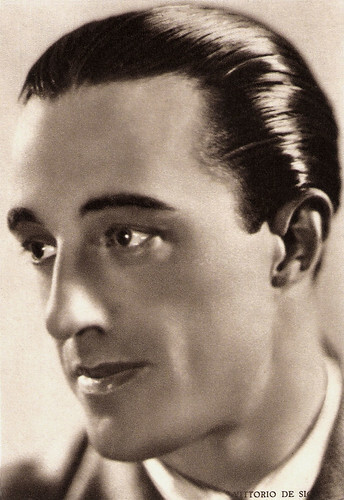
Italian postcard by Rizzoli S.C., Milano, 1936.
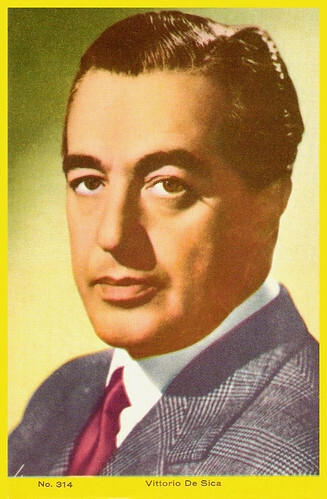
Mexican card, no. 314.
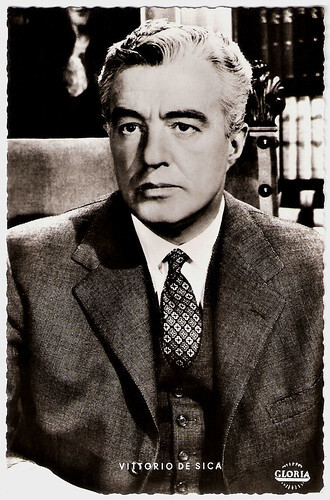
German postcard by Kunst und Bild, Berlin, no. V 377. Photo: Gloria Film. Publicity still for Racconti Romani/Roman Tales (Gianni Franciolini, 1955).
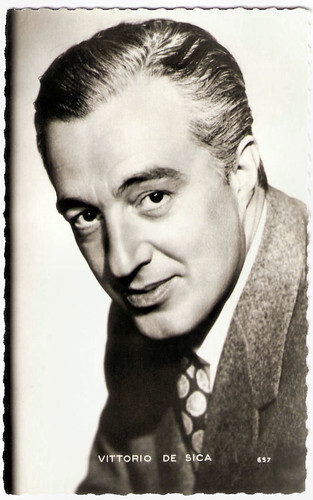
French postcard by Editions P.I., no. 37 G, presented by Les Carbones Korès Carboplane. Photo: Sam Lévin.
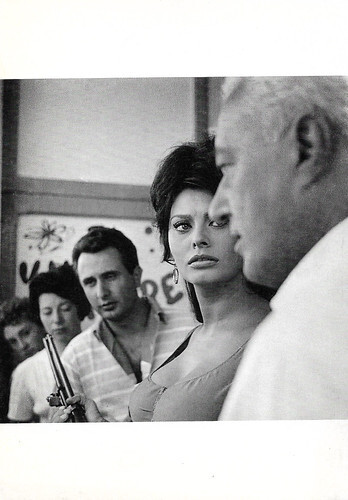
French postcard in the Collection Cinéma series by La Malibran, Paris, 1990, no. CI 13. Sophia Loren and Vittorio De Sica on the set of Boccaccio '70 (Vittorio De Sica, a.o., 1962).
Successful matinee idol
Vittorio Domenico Stanislao Gaetano Sorano De Sica was born in Sora, Italy in 1901 (or 1902 - sources are divided). He grew up in Naples. His father, Umberto De Sica, a bank clerk with a penchant for show business, encouraged his good-looking son to pursue a stage career. Vittorio made his screen debut at 16 in the film Il processo Clémenceau/The Clemenceau Affair (Alfredo De Antoni, 1917) starring the legendary diva Francesca Bertini .
He began his career as a theatre actor in the early 1920s and joined Tatiana Pavlova 's theatre company in 1923. By the late 1920s, he was a successful matinee idol of the Italian stage and also appeared in such silent films as La Bellezza del mondo/Beauty of the World (Mario Almirante, 1927) starring another silent film diva, Italia Almirante-Manzini .
In 1933 De Sica founded his own theatre company with his wife, actress Giuditta Rissone, and Sergio Tofano. The company performed mostly light comedies. His good looks and breezy manner made him an overnight matinee idol of the Italian cinema with the release of his first sound picture, La Vecchia Signora/The Old Lady (Amleto Palermi, 1932).
Light comedies as Gli uomini che mascalzoni!/What Scoundrels Men Are! (Mario Camerini, 1932) and Il Signor Max/Mister Max (Mario Camerini, 1937) made him immensely popular with female audiences. During the Second World War De Sica turned to directing with Rose Scarlatte/Red Roses (Vittorio De Sica, Giuseppe Amato, 1940), and Maddelena, Zero in Condotta/Maddelena, Zero For Conduct (Vittorio De Sica, 1940).
Both films were attempts to bring theatre pieces to the screen with suitable roles for himself. In the Comedy of Errors Teresa Venerdi (Vittorio De Sica, 1941) his girlfriend was played by a young Anna Magnani .
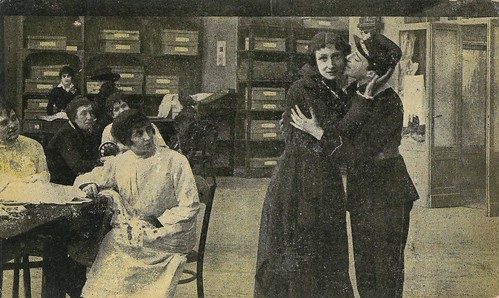
Spanish postcard by Amatller Marca Luna chocolate, Series 2a, no. 1. Photo: Caesar Film. A young Vittorio De Sica in Il processo Clémenceau (Alfredo De Antoni, 1917), starring Francesca Bertini. In Spain, the film was released as El proceso Clemenceau. In the film, this scene is mirrored. Young Pierre Clemenceau tells his mother he has won the first prize and may start working at the sculptor studio of the father of his friend Costantino.
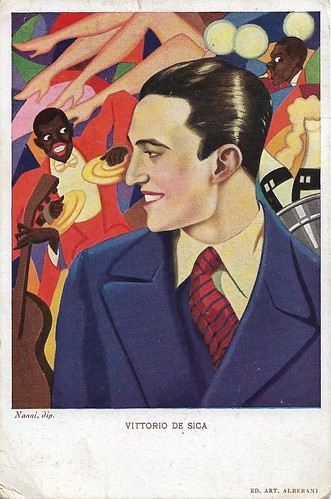
Italian postcard by Edizioni artistiche Alberani. Portrait by Nanni. Alberani was a Bologna-based pharmaceutic company, which for decades made publicity for its 'sali di frutta'. Here Vittorio De Sica is clearly associated with the Jazz Age.
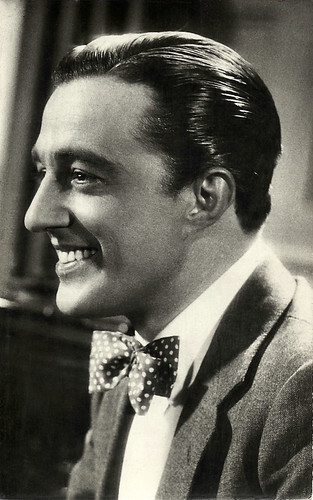
Spanish postcard by Editorial Brujuero, Barcelona, no. 481. Photo: Infonal, Archivo Bermeja.
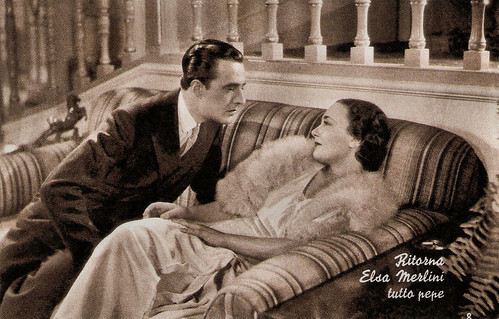
Italian postcard. The caption reads: Elsa Merlini returns, all pepper. Probably for the film Non ti conosco più/I Don't Know You Anymore (Nunzio Malasomma, Mario Bonnard, 1936). The pepper refers to the title of her previous film Paprika (Carl Boese, 1933).
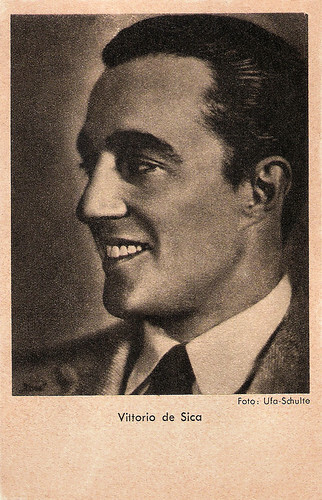
German postcard by Das Programm von Heute, Berlin. Photo: Ufa / Schulte.
Real locations and non-professional actors
A turning point in Vittorio De Sica’s career was his meeting with the writer Cesare Zavattini. They worked together on De Sica’s fifth film, I bambini ci guardano/The Children Are Watching Us (Vittorio De Sica, 1943). In this film, the director began to use non-professional actors and socially conscious subject matter. He revealed hitherto unsuspected depths and an extraordinarily sensitive touch with actors, especially with children.
I bambini ci guardano/The Children Are Watching Us is a mature, perceptive, and deeply human work about the impact of adult folly on a child's innocent mind. Zavattini became a scenarist and his major collaborator for the next three decades.
Together they created two of the most significant films of the Italian neorealism movement: Sciuscià/Shoeshine (Vittorio de Sica, 1946) and Ladri di biciclette/Bicycle Thieves (Vittorio de Sica, 1948). Sciuscià/Shoeshine is the story of how the lasting friendship of two homeless boys, who make their living shining shoes for the American G.I.'s, is betrayed by their contact with adults. At the end of the film, one boy inadvertently causes the other's death.
In Ladri di biciclette/Bicycle Thieves, workman Ricci's desperate search for his bicycle is an odyssey that enables us to witness a varied collection of characters and situations among the poor and working class of Rome. At Sony Pictures Classics , an anonymous critic writes: “With no money available to produce his films, De Sica initiated the use of real locations and non-professional actors. Using available light and documentary effects, he explored the relationship between working and lower-class characters in an indifferent, and often hostile social and political environment. The result was gritty and searing storytelling that not only bared the truth about the harsh conditions inflicted on Italy's poor but also represented a radical break from filmmaking conventions.” Both films are heartbreaking studies of poverty in postwar Italy and both won special Oscars before the foreign film category was officially established.
De Sica's next collaboration with Zavattini was the satirical fantasy, Miracolo a Milano/Miracle in Milan (Vittorio de Sica, 1951), which wavered between optimism and despair in its allegorical treatment of the plight of the poor in an industrial society. Umberto D. (Vittorio de Sica, 1952), was a relentlessly bleak study of the problems of old age and loneliness, but it was a box-office disaster. Continually wooed by Hollywood, De Sica finally acquiesced to make Stazioni Termini (Vittorio de Sica, 1952), clumsily renamed Indiscretion of an American Wife in the US. It was produced by David O. Selznick and filmed in Rome with Selznick's wife, Jennifer Jones and Montgomery Clift in the leading roles. Unfortunately, neorealist representation formed only an insignificant background to this typically American star vehicle.
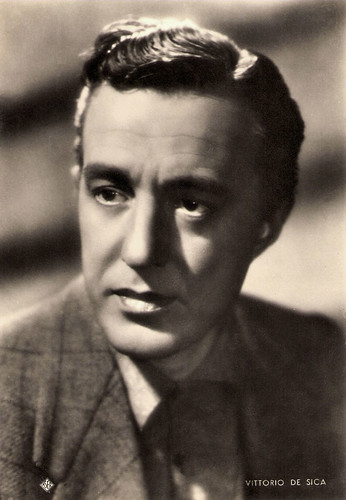
Italian postcard by Aser, Roma (Rome), no. 333. Photo: Vaselli.
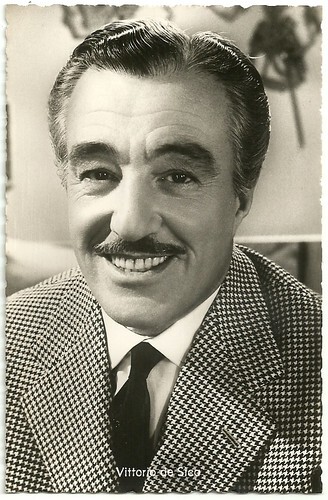
German postcard by Kolibri-Verlag, Minden. Photo: Bavaria Filmkunst-Eichberg-Marszalos. Publicity still for the Franco-Italian-German film Casino de Paris (André Hunebelle, 1957).
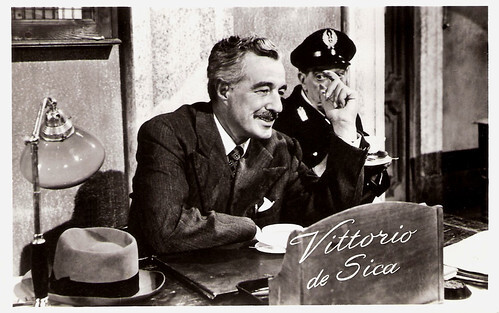
Dutch postcard by Takken, no. 1679.
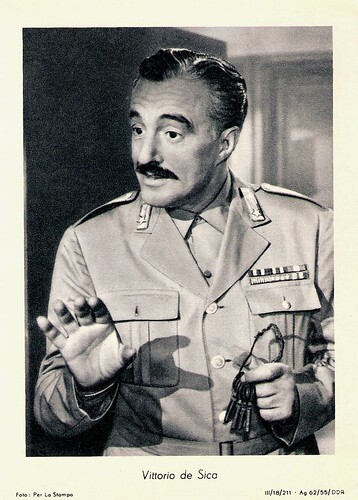
East-German postcard, no. III/18/211, 1955. Photo: Per la Stampa. De Sica wears the uniform of the marshall from the film Pane, amore e fantasia (and its sequels).
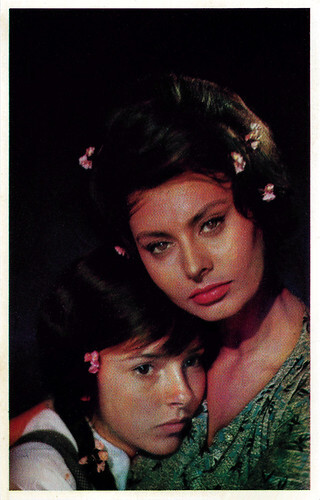
Belgian postcard by Ets. Dagneaux & Co. for STAR, Chewing-gum. Sophia Loren and Eleonora Brown in La ciociara/Two Women (Vittorio De Sica, 1960).
Bread love and dreams
During his lifetime, Vittorio De Sica acted in over one hundred films in Italy and abroad, to finance his own directorial projects. He turned almost exclusively to acting in the late 1950s, enjoying great popularity in the role of the rural police officer Carotenuto in Pane, amore e fantasia/Bread, Love and Dreams (Luigi Comencini, 1954) opposite Gina Lollobrigida . He returned in a subsequent comedy series of the same name co-starring Lollobrigida or Sophia Loren .
He was at his best playing breezy comic heroes, men of great self-assurance or confidence - such as in Rossellini's General Della Rovere (Roberto Rossellini, 1959). On TV he became well known in the British Series The Four Just Men (1959) produced by Sapphire Films. With the notable exception of Il Tetto/The Roof (Vittorio de Sica, 1956) and La Ciociara/Two Women (Vittorio de Sica, 1960), for which Sophia Loren won an Oscar for Best Actress, his subsequent output as a director was for a long while markedly less inspired and significant.
He had two box-office hits with Matrimonio All'Italiana/Marriage Italian Style (Vittorio de Sica, 1964) starring Loren and Marcello Mastroianni , and with Ieri, oggi, domain/Yesterday, Today and Tomorrow (Vittorio de Sica, 1964) which won him another Oscar. However, critics and audiences alike had concluded that the ageing director had lost his touch, but, just before he died he made a dramatic comeback with Il giardino dei Finzi Contini/The Garden of the Finzi-Continis (Vittorio de Sica, 1970). The film was based on a Bassani novel about the incarceration of Italian Jews during the war.
According to Joel Kanoff at Film Reference, it shows “a strong Viscontian influence in its lavish setting and thematics (the film deals with the dissolution of the bourgeois family).” It won him yet another Oscar. The director's next film was Una breve vacanza/A Brief Vacation (Vittorio de Sica, 1973), about a working-class Italian woman's first taste of freedom in a society dominated by males. His last film, Il Viaggio/The Voyage (Vittorio de Sica, 1974), was based on a novella by Luigi Pirandello.
That year, he passed away following the removal of a cyst from his lungs. He had been married to Giuditta Rissone (1937-1968) and to Spanish actress María Mercader (1968-1974) with whom he had two sons, composer-director Manuel De Sica and actor-singer Christian De Sica. De Sica lived with Mercader from 1942 on, but couldn't marry her until 1968 after acquiring French citizenship, which allowed him to finally divorce Rissone. In 1974, Vittorio De Sica died near Paris in Neuilly-sur-Seine, at the age of 72. Active to the end, he appeared as himself in Scola's melancholic comedy-drama C'eravamo tanto amati/We All Loved Each Other So Much (Ettore Scola, 1974), which was released after his death.
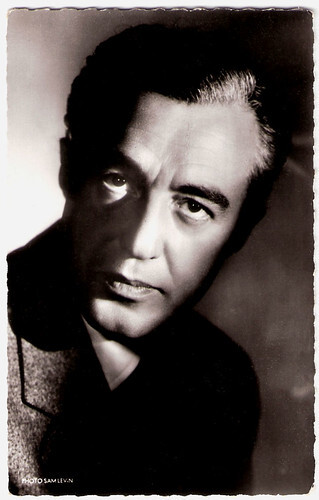
French postcard by Editions du Globe, Paris, no. 610. Photo: Sam Lévin.
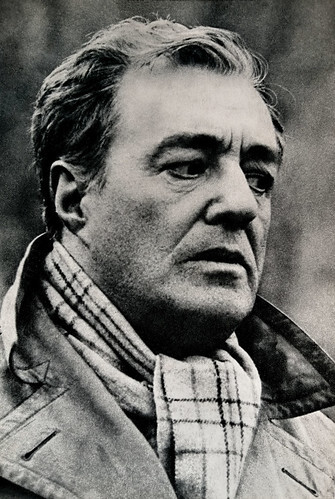
Romanian postcard by Casa Filmului Acin. Collection: Alina Deaconu.
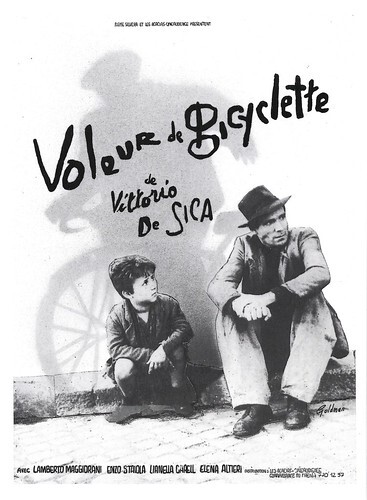
Postcard, reproduction of French poster based on a classic still from Ladri di biciclette/Bicycle Thieves (Vittorio De Sica, 1948), with Lamberto Maggiorani and Enzo Staiola.
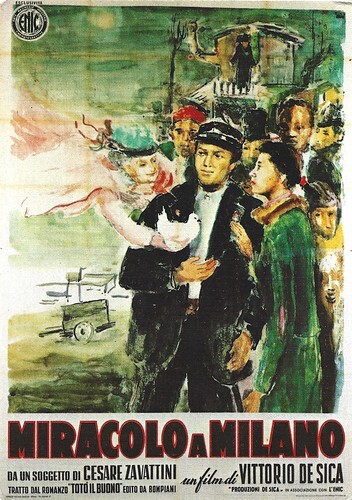
Postcard, reproduction of Italian poster for Miracolo a Milano (Vittorio De Sica, 1951) by ENIC. Poster design: Ercole Brini.
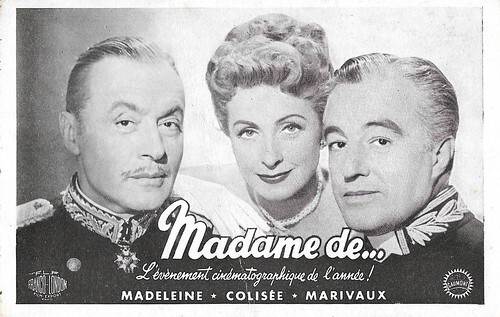
French postcard. Gaumont. F.L.F. Franco-London Film Export. Publicity for the film at the Parisian cinemas Madeleine, Colisée, and Marivaux. Charles Boyer , Danielle Darrieux , and Vittorio De Sica in Madame de... (Max Ophüls, 1953).
Scene from Miracolo a Milano/Miracle in Milan (1953). Source: Franco Maria Fontana (YouTube).
Sophia Loren and Vittorio De Sica dance the mambo in Pane, amore e.../Bread, Love and ... (1955). Source: Il Romanziere (YouTube).
Sources: Joel Kanoff (Film Reference), Dan Harper (Senses of Cinema), (IMDb), TCM, Sony Pictures Classics, Wikipedia and .

Italian postcard by Rizzoli S.C., Milano, 1936.

Mexican card, no. 314.

German postcard by Kunst und Bild, Berlin, no. V 377. Photo: Gloria Film. Publicity still for Racconti Romani/Roman Tales (Gianni Franciolini, 1955).

French postcard by Editions P.I., no. 37 G, presented by Les Carbones Korès Carboplane. Photo: Sam Lévin.

French postcard in the Collection Cinéma series by La Malibran, Paris, 1990, no. CI 13. Sophia Loren and Vittorio De Sica on the set of Boccaccio '70 (Vittorio De Sica, a.o., 1962).
Successful matinee idol
Vittorio Domenico Stanislao Gaetano Sorano De Sica was born in Sora, Italy in 1901 (or 1902 - sources are divided). He grew up in Naples. His father, Umberto De Sica, a bank clerk with a penchant for show business, encouraged his good-looking son to pursue a stage career. Vittorio made his screen debut at 16 in the film Il processo Clémenceau/The Clemenceau Affair (Alfredo De Antoni, 1917) starring the legendary diva Francesca Bertini .
He began his career as a theatre actor in the early 1920s and joined Tatiana Pavlova 's theatre company in 1923. By the late 1920s, he was a successful matinee idol of the Italian stage and also appeared in such silent films as La Bellezza del mondo/Beauty of the World (Mario Almirante, 1927) starring another silent film diva, Italia Almirante-Manzini .
In 1933 De Sica founded his own theatre company with his wife, actress Giuditta Rissone, and Sergio Tofano. The company performed mostly light comedies. His good looks and breezy manner made him an overnight matinee idol of the Italian cinema with the release of his first sound picture, La Vecchia Signora/The Old Lady (Amleto Palermi, 1932).
Light comedies as Gli uomini che mascalzoni!/What Scoundrels Men Are! (Mario Camerini, 1932) and Il Signor Max/Mister Max (Mario Camerini, 1937) made him immensely popular with female audiences. During the Second World War De Sica turned to directing with Rose Scarlatte/Red Roses (Vittorio De Sica, Giuseppe Amato, 1940), and Maddelena, Zero in Condotta/Maddelena, Zero For Conduct (Vittorio De Sica, 1940).
Both films were attempts to bring theatre pieces to the screen with suitable roles for himself. In the Comedy of Errors Teresa Venerdi (Vittorio De Sica, 1941) his girlfriend was played by a young Anna Magnani .

Spanish postcard by Amatller Marca Luna chocolate, Series 2a, no. 1. Photo: Caesar Film. A young Vittorio De Sica in Il processo Clémenceau (Alfredo De Antoni, 1917), starring Francesca Bertini. In Spain, the film was released as El proceso Clemenceau. In the film, this scene is mirrored. Young Pierre Clemenceau tells his mother he has won the first prize and may start working at the sculptor studio of the father of his friend Costantino.

Italian postcard by Edizioni artistiche Alberani. Portrait by Nanni. Alberani was a Bologna-based pharmaceutic company, which for decades made publicity for its 'sali di frutta'. Here Vittorio De Sica is clearly associated with the Jazz Age.

Spanish postcard by Editorial Brujuero, Barcelona, no. 481. Photo: Infonal, Archivo Bermeja.

Italian postcard. The caption reads: Elsa Merlini returns, all pepper. Probably for the film Non ti conosco più/I Don't Know You Anymore (Nunzio Malasomma, Mario Bonnard, 1936). The pepper refers to the title of her previous film Paprika (Carl Boese, 1933).

German postcard by Das Programm von Heute, Berlin. Photo: Ufa / Schulte.
Real locations and non-professional actors
A turning point in Vittorio De Sica’s career was his meeting with the writer Cesare Zavattini. They worked together on De Sica’s fifth film, I bambini ci guardano/The Children Are Watching Us (Vittorio De Sica, 1943). In this film, the director began to use non-professional actors and socially conscious subject matter. He revealed hitherto unsuspected depths and an extraordinarily sensitive touch with actors, especially with children.
I bambini ci guardano/The Children Are Watching Us is a mature, perceptive, and deeply human work about the impact of adult folly on a child's innocent mind. Zavattini became a scenarist and his major collaborator for the next three decades.
Together they created two of the most significant films of the Italian neorealism movement: Sciuscià/Shoeshine (Vittorio de Sica, 1946) and Ladri di biciclette/Bicycle Thieves (Vittorio de Sica, 1948). Sciuscià/Shoeshine is the story of how the lasting friendship of two homeless boys, who make their living shining shoes for the American G.I.'s, is betrayed by their contact with adults. At the end of the film, one boy inadvertently causes the other's death.
In Ladri di biciclette/Bicycle Thieves, workman Ricci's desperate search for his bicycle is an odyssey that enables us to witness a varied collection of characters and situations among the poor and working class of Rome. At Sony Pictures Classics , an anonymous critic writes: “With no money available to produce his films, De Sica initiated the use of real locations and non-professional actors. Using available light and documentary effects, he explored the relationship between working and lower-class characters in an indifferent, and often hostile social and political environment. The result was gritty and searing storytelling that not only bared the truth about the harsh conditions inflicted on Italy's poor but also represented a radical break from filmmaking conventions.” Both films are heartbreaking studies of poverty in postwar Italy and both won special Oscars before the foreign film category was officially established.
De Sica's next collaboration with Zavattini was the satirical fantasy, Miracolo a Milano/Miracle in Milan (Vittorio de Sica, 1951), which wavered between optimism and despair in its allegorical treatment of the plight of the poor in an industrial society. Umberto D. (Vittorio de Sica, 1952), was a relentlessly bleak study of the problems of old age and loneliness, but it was a box-office disaster. Continually wooed by Hollywood, De Sica finally acquiesced to make Stazioni Termini (Vittorio de Sica, 1952), clumsily renamed Indiscretion of an American Wife in the US. It was produced by David O. Selznick and filmed in Rome with Selznick's wife, Jennifer Jones and Montgomery Clift in the leading roles. Unfortunately, neorealist representation formed only an insignificant background to this typically American star vehicle.

Italian postcard by Aser, Roma (Rome), no. 333. Photo: Vaselli.

German postcard by Kolibri-Verlag, Minden. Photo: Bavaria Filmkunst-Eichberg-Marszalos. Publicity still for the Franco-Italian-German film Casino de Paris (André Hunebelle, 1957).

Dutch postcard by Takken, no. 1679.

East-German postcard, no. III/18/211, 1955. Photo: Per la Stampa. De Sica wears the uniform of the marshall from the film Pane, amore e fantasia (and its sequels).

Belgian postcard by Ets. Dagneaux & Co. for STAR, Chewing-gum. Sophia Loren and Eleonora Brown in La ciociara/Two Women (Vittorio De Sica, 1960).
Bread love and dreams
During his lifetime, Vittorio De Sica acted in over one hundred films in Italy and abroad, to finance his own directorial projects. He turned almost exclusively to acting in the late 1950s, enjoying great popularity in the role of the rural police officer Carotenuto in Pane, amore e fantasia/Bread, Love and Dreams (Luigi Comencini, 1954) opposite Gina Lollobrigida . He returned in a subsequent comedy series of the same name co-starring Lollobrigida or Sophia Loren .
He was at his best playing breezy comic heroes, men of great self-assurance or confidence - such as in Rossellini's General Della Rovere (Roberto Rossellini, 1959). On TV he became well known in the British Series The Four Just Men (1959) produced by Sapphire Films. With the notable exception of Il Tetto/The Roof (Vittorio de Sica, 1956) and La Ciociara/Two Women (Vittorio de Sica, 1960), for which Sophia Loren won an Oscar for Best Actress, his subsequent output as a director was for a long while markedly less inspired and significant.
He had two box-office hits with Matrimonio All'Italiana/Marriage Italian Style (Vittorio de Sica, 1964) starring Loren and Marcello Mastroianni , and with Ieri, oggi, domain/Yesterday, Today and Tomorrow (Vittorio de Sica, 1964) which won him another Oscar. However, critics and audiences alike had concluded that the ageing director had lost his touch, but, just before he died he made a dramatic comeback with Il giardino dei Finzi Contini/The Garden of the Finzi-Continis (Vittorio de Sica, 1970). The film was based on a Bassani novel about the incarceration of Italian Jews during the war.
According to Joel Kanoff at Film Reference, it shows “a strong Viscontian influence in its lavish setting and thematics (the film deals with the dissolution of the bourgeois family).” It won him yet another Oscar. The director's next film was Una breve vacanza/A Brief Vacation (Vittorio de Sica, 1973), about a working-class Italian woman's first taste of freedom in a society dominated by males. His last film, Il Viaggio/The Voyage (Vittorio de Sica, 1974), was based on a novella by Luigi Pirandello.
That year, he passed away following the removal of a cyst from his lungs. He had been married to Giuditta Rissone (1937-1968) and to Spanish actress María Mercader (1968-1974) with whom he had two sons, composer-director Manuel De Sica and actor-singer Christian De Sica. De Sica lived with Mercader from 1942 on, but couldn't marry her until 1968 after acquiring French citizenship, which allowed him to finally divorce Rissone. In 1974, Vittorio De Sica died near Paris in Neuilly-sur-Seine, at the age of 72. Active to the end, he appeared as himself in Scola's melancholic comedy-drama C'eravamo tanto amati/We All Loved Each Other So Much (Ettore Scola, 1974), which was released after his death.

French postcard by Editions du Globe, Paris, no. 610. Photo: Sam Lévin.

Romanian postcard by Casa Filmului Acin. Collection: Alina Deaconu.

Postcard, reproduction of French poster based on a classic still from Ladri di biciclette/Bicycle Thieves (Vittorio De Sica, 1948), with Lamberto Maggiorani and Enzo Staiola.

Postcard, reproduction of Italian poster for Miracolo a Milano (Vittorio De Sica, 1951) by ENIC. Poster design: Ercole Brini.

French postcard. Gaumont. F.L.F. Franco-London Film Export. Publicity for the film at the Parisian cinemas Madeleine, Colisée, and Marivaux. Charles Boyer , Danielle Darrieux , and Vittorio De Sica in Madame de... (Max Ophüls, 1953).
Scene from Miracolo a Milano/Miracle in Milan (1953). Source: Franco Maria Fontana (YouTube).
Sophia Loren and Vittorio De Sica dance the mambo in Pane, amore e.../Bread, Love and ... (1955). Source: Il Romanziere (YouTube).
Sources: Joel Kanoff (Film Reference), Dan Harper (Senses of Cinema), (IMDb), TCM, Sony Pictures Classics, Wikipedia and .
Published on November 19, 2023 22:00
November 18, 2023
Hilde von Stolz
Hilde von Stolz (1903-1973) was a blonde Austrian leading lady and supporting actress in Ufa films of the 1930s and 1940s.
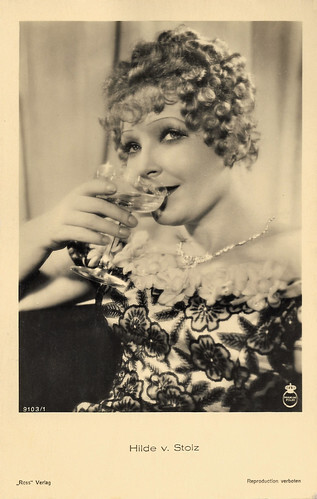
German postcard by Ross-Verlag, Berlin, no. 9103/1, 1935-1936. Photo: Maxim-Film.
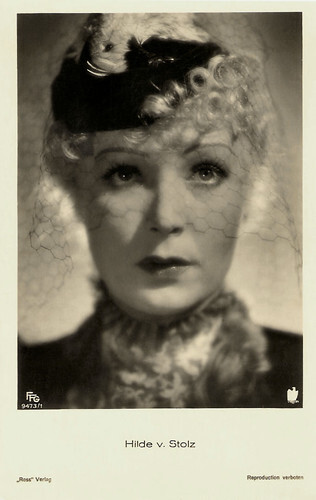
German postcard by Ross Verlag, Berlin, no. 9473/1, 1935-1936. Photo: FFG (Froelich-Film GmbH). Hilde von Stolz in Traumulus/The Dreamer (Carl Froelich, 1936).
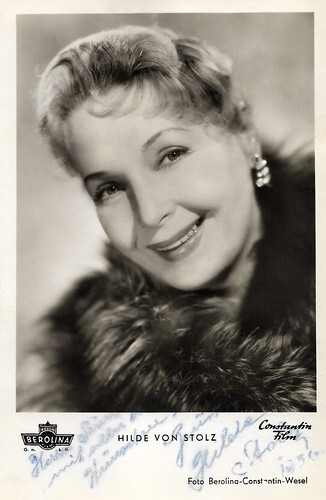
West German postcard by Kunst und Bild, Berlin, no. I 462. Photo: Berolina / Constantin / Wesel. Hilde von Stolz in Charley's Tante/Charley's Aunt (Hans Quest, 1955).
Ingénues, femmes fatales and elegant ladies
Hilde von Stolz was born Hilda Stolz in 1903 in Klausenburg/Schäßburg, Hungary, Austria-Hungary, now Cluj-Napoca, Romania. She was the daughter of an officer, but according to a surviving family tree, her father Karl Stolz was a "station chief".
Hilde was trained for acting at the Max-Reinhardt-Seminar in Vienna, against the wish of her parents. There she also made her theatre debut at the Kammerspiele, where she appeared as Wendla in Frank Wedekind's 'Frühlingserwachen' (Spring Awakening). She subsequently performed at various theatres in Vienna and later at the Theater am Schiffbauerdamm and Lustspielhaus des Westens in Berlin.
Her film debut was in the Austrian silent film Der Schulmeister vom Lichtenthal/The Melody Master (James A. FitzPatrick, 1928) under the pseudonym Helen Steels. The author and director of this film about the composer Franz Schubert, James A. FitzPatrick, was making portraits of artists at the time and later became famous for his travel documentaries. According to the magazine Filmwelt (1934), it was also FitzPatrick who suggested Hilde use the pseudonym "Helen Steels" because "Hilde von Stolz" was a "name impossible for film in America". The young actress probably dreamed of a career in Hollywood.
That same year, she moved to Berlin. In her first German film, she played the lead role opposite Reinhold Schünzel in the comedy Don Juan in der Mädchenschule/Don Juan in a Girls' School (Reinhold Schünzel, 1928). She used the pseudonym Helen Steels till 1933.
At the Ufa, she established herself as a major film actress although she had to be satisfied with major supporting roles in well-known films such as Zu neuen Ufern/To New Shores (Detlef Sierck, 1937) with Zarah Leander and Kleiner Mann - ganz gross!/Kleiner Mann - ganz groß!/Little man - big time! (Robert A. Stemmle, 1938). She was often cast as ingénues, femmes fatales, elegant ladies, dancers or actresses.
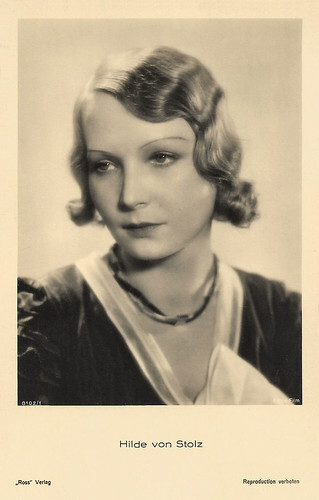
German postcard by Ross-Verlag, Berlin, no. 8102/1, 1933-1934. Photo: Ethos Film.
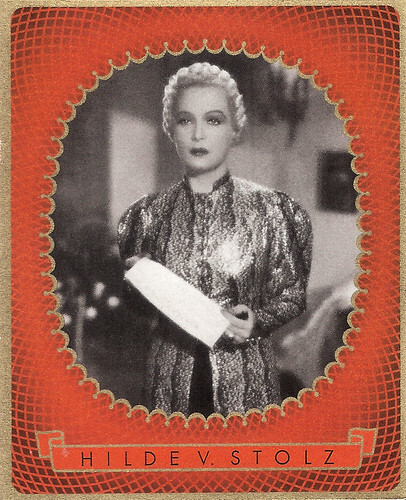
German collectors card for Caid in the Bunte Filmbilder series by Ross Verlag, series II, no. 394. Photo: Bavaria.
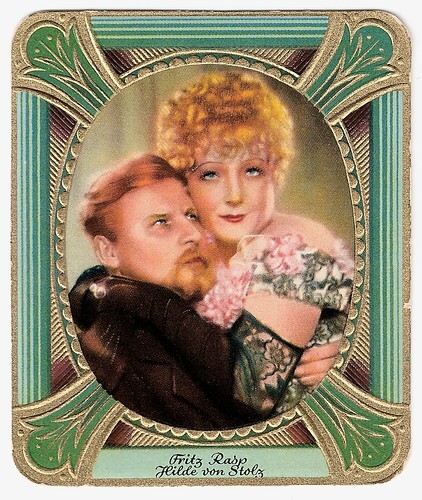
German cigarette card by Garbaty in the Moderne Schonheitsgalerie, Series 2, no. 188, issued in Kur Mark Cigarettes. Fritz Rasp and Hilde von Stolz in Lockspitzel Asew/Double-Agent Asew (Phil Jutzi, 1935).
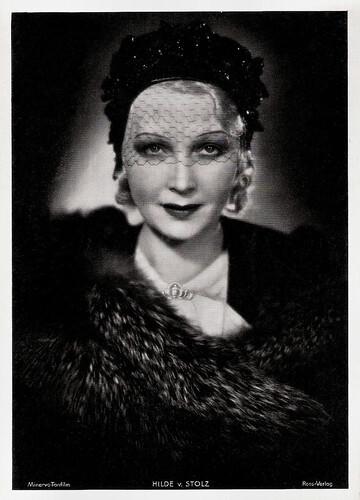
Big collectors card by Ross-Verlag, Berlin. Photo: Minerva-Tonfilm. Hilde von Stolz in Stärker als Paragraphen/Stronger Than Paragraphs (Jürgen von Alten, 1936).
Jud Süss
Hilde von Stolz followed the political events in Germany critically and finally helped Jews to leave Germany. When she decided to leave Germany herself the outbreak of World War II nullified her plans and she had to stay in Germany.
She continued her career during wartime and appeared among others as the wife of Duke Karl Alexander in the controversial propaganda film Jud Süss/Süss, the Jew (Veit Harlan, 1940) but also in films like the biopic Diesel (Gerhard Lamprecht, 1942) starring Willy Birgel and Münchhausen (Josef von Báky, 1942) starring Hans Albers .
Diesel portrays the life of Rudolf Diesel, the German inventor of the diesel engine. It was one of a series of prestigious biopics made in Nazi Germany portraying genius inventors or artists struggling against the societies in which they live.
After the war, she only appeared in a few more films. Her last films include the melodrama Ehe im Schatten/Marriage in the Shadows (Kurt Maetzig, 1947) released by DEFA, the comedy Charleys Tante/Charley's Aunt (Hans Quest, 1955) with Heinz Rühmann and Die Trapp-Familie/The Trapp Family (Wolfgang Liebeneiner, 1956) starring Ruth Leuwerik . Die Trapp-Familie became one of the most successful German films of the 1950s and was the inspiration for the even more fictionalised Broadway musical 'The Sound of Music' (1959), and its highly successful 1965 film version.
Her final screen appearance was in the TV movie Ein Mann Gottes/A man of God (Oswald Döpke, 1967). Hilde von Stolz died in 1973 in West Berlin, West Germany. She was buried in the family vault. Hilde von Stolz's private life is shrouded in mystery. There is no information about her relationships.

German postcard by Ross Verlag for Das Programm von Heute, Berlin. Photo: Deka-Film. This postcard was a gift by Miss Mertens.
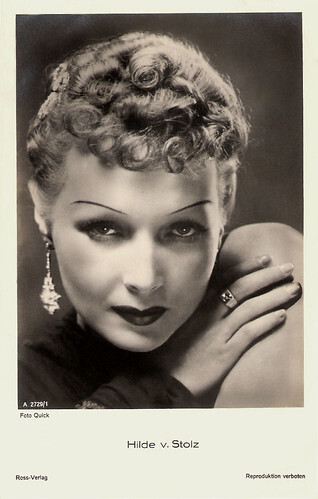
German postcard by Ross Verlag, no. A 2729/1, 1939-1940. Photo: Quick.
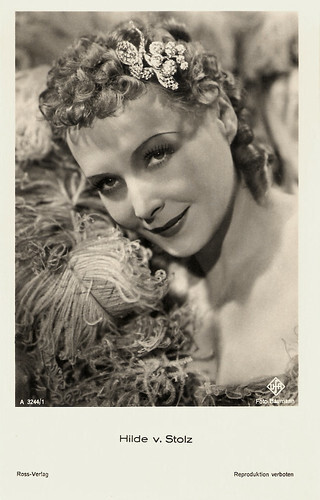
German postcard by Ross Verlag, no. A 3244/1, 1941-1944. Photo: Baumann / Ufa.
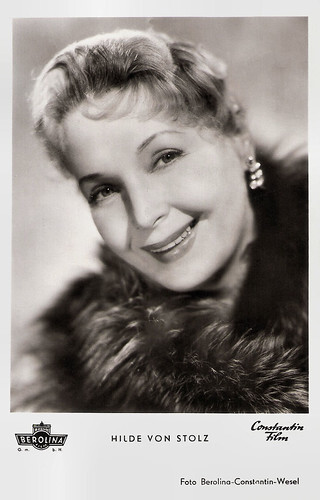
West German postcard by Kunst und Bild, Berlin, no. I 462. Photo: Berolina / Constantin / Wesel. Hilde von Stolz in Charley's Tante/Charley's Aunt (Hans Quest, 1955).
Sources: Johannes Ackner (RICHARD-ACKNER-ARCHIV - German), Wikipedia (English and German) and .

German postcard by Ross-Verlag, Berlin, no. 9103/1, 1935-1936. Photo: Maxim-Film.

German postcard by Ross Verlag, Berlin, no. 9473/1, 1935-1936. Photo: FFG (Froelich-Film GmbH). Hilde von Stolz in Traumulus/The Dreamer (Carl Froelich, 1936).

West German postcard by Kunst und Bild, Berlin, no. I 462. Photo: Berolina / Constantin / Wesel. Hilde von Stolz in Charley's Tante/Charley's Aunt (Hans Quest, 1955).
Ingénues, femmes fatales and elegant ladies
Hilde von Stolz was born Hilda Stolz in 1903 in Klausenburg/Schäßburg, Hungary, Austria-Hungary, now Cluj-Napoca, Romania. She was the daughter of an officer, but according to a surviving family tree, her father Karl Stolz was a "station chief".
Hilde was trained for acting at the Max-Reinhardt-Seminar in Vienna, against the wish of her parents. There she also made her theatre debut at the Kammerspiele, where she appeared as Wendla in Frank Wedekind's 'Frühlingserwachen' (Spring Awakening). She subsequently performed at various theatres in Vienna and later at the Theater am Schiffbauerdamm and Lustspielhaus des Westens in Berlin.
Her film debut was in the Austrian silent film Der Schulmeister vom Lichtenthal/The Melody Master (James A. FitzPatrick, 1928) under the pseudonym Helen Steels. The author and director of this film about the composer Franz Schubert, James A. FitzPatrick, was making portraits of artists at the time and later became famous for his travel documentaries. According to the magazine Filmwelt (1934), it was also FitzPatrick who suggested Hilde use the pseudonym "Helen Steels" because "Hilde von Stolz" was a "name impossible for film in America". The young actress probably dreamed of a career in Hollywood.
That same year, she moved to Berlin. In her first German film, she played the lead role opposite Reinhold Schünzel in the comedy Don Juan in der Mädchenschule/Don Juan in a Girls' School (Reinhold Schünzel, 1928). She used the pseudonym Helen Steels till 1933.
At the Ufa, she established herself as a major film actress although she had to be satisfied with major supporting roles in well-known films such as Zu neuen Ufern/To New Shores (Detlef Sierck, 1937) with Zarah Leander and Kleiner Mann - ganz gross!/Kleiner Mann - ganz groß!/Little man - big time! (Robert A. Stemmle, 1938). She was often cast as ingénues, femmes fatales, elegant ladies, dancers or actresses.

German postcard by Ross-Verlag, Berlin, no. 8102/1, 1933-1934. Photo: Ethos Film.

German collectors card for Caid in the Bunte Filmbilder series by Ross Verlag, series II, no. 394. Photo: Bavaria.

German cigarette card by Garbaty in the Moderne Schonheitsgalerie, Series 2, no. 188, issued in Kur Mark Cigarettes. Fritz Rasp and Hilde von Stolz in Lockspitzel Asew/Double-Agent Asew (Phil Jutzi, 1935).

Big collectors card by Ross-Verlag, Berlin. Photo: Minerva-Tonfilm. Hilde von Stolz in Stärker als Paragraphen/Stronger Than Paragraphs (Jürgen von Alten, 1936).
Jud Süss
Hilde von Stolz followed the political events in Germany critically and finally helped Jews to leave Germany. When she decided to leave Germany herself the outbreak of World War II nullified her plans and she had to stay in Germany.
She continued her career during wartime and appeared among others as the wife of Duke Karl Alexander in the controversial propaganda film Jud Süss/Süss, the Jew (Veit Harlan, 1940) but also in films like the biopic Diesel (Gerhard Lamprecht, 1942) starring Willy Birgel and Münchhausen (Josef von Báky, 1942) starring Hans Albers .
Diesel portrays the life of Rudolf Diesel, the German inventor of the diesel engine. It was one of a series of prestigious biopics made in Nazi Germany portraying genius inventors or artists struggling against the societies in which they live.
After the war, she only appeared in a few more films. Her last films include the melodrama Ehe im Schatten/Marriage in the Shadows (Kurt Maetzig, 1947) released by DEFA, the comedy Charleys Tante/Charley's Aunt (Hans Quest, 1955) with Heinz Rühmann and Die Trapp-Familie/The Trapp Family (Wolfgang Liebeneiner, 1956) starring Ruth Leuwerik . Die Trapp-Familie became one of the most successful German films of the 1950s and was the inspiration for the even more fictionalised Broadway musical 'The Sound of Music' (1959), and its highly successful 1965 film version.
Her final screen appearance was in the TV movie Ein Mann Gottes/A man of God (Oswald Döpke, 1967). Hilde von Stolz died in 1973 in West Berlin, West Germany. She was buried in the family vault. Hilde von Stolz's private life is shrouded in mystery. There is no information about her relationships.

German postcard by Ross Verlag for Das Programm von Heute, Berlin. Photo: Deka-Film. This postcard was a gift by Miss Mertens.

German postcard by Ross Verlag, no. A 2729/1, 1939-1940. Photo: Quick.

German postcard by Ross Verlag, no. A 3244/1, 1941-1944. Photo: Baumann / Ufa.

West German postcard by Kunst und Bild, Berlin, no. I 462. Photo: Berolina / Constantin / Wesel. Hilde von Stolz in Charley's Tante/Charley's Aunt (Hans Quest, 1955).
Sources: Johannes Ackner (RICHARD-ACKNER-ARCHIV - German), Wikipedia (English and German) and .
Published on November 18, 2023 22:00
November 17, 2023
Elaine Stewart
Ravishing redhead Elaine Stewart (1930-2011) was a glamorous American actress and model. During the 1950s, she starred in a dozen films before turning to television.

West German postcard by Universum-FilmAG, Abt. Film-Foto, Berlin-Tempelhof, no. FK 510. Photo: Metro-Goldwyn-Mayer. (The logo is printed in reverse).

British postcard in the Picturegoer Series, London, no. D. 387. Photo: Metro-Goldwyn-Mayer.

Vintage postcard by I.F.P.A., no. 8.
Miss See
Elaine Stewart was born Elsy Henrietta Maria Steinberg in Montclair, New Jersey, in 1930. She was the daughter of Jewish German immigrants, Maria Hedwig (Hänssler) and Ulrich Ernst Steinberg, a police sergeant. Elsy developed into a beautiful young woman and while still a teen, she was taken on by the Conover Modeling Agency.
She made her modelling debut by winning Miss See in See Magazine in 1952. Changing her name to the more glamorous-sounding Elaine Stewart, she was in many magazines such as Life and Photoplay. Her portfolio and beauty awards eventually caught the attention of Hollywood executives.
Hal B. Wallis offered her $200 a week to play the small, unbilled role of a nurse in the Dean Martin and Jerry Lewis slapstick comedy Sailor Beware (Hal Walker, 1952). MGM subsequently signed the glamour girl to a contract to build her up as a dark-haired Marilyn Monroe type. The build-up was gradual with window-dressing bits as a chorine, stewardess and the like in such MGM films as Singin' in the Rain (Stanley Donen, Gene Kelly, 1952), You for Me (Don Weis, 1952) and Everything I Have Is Yours (Robert Z. Leonard, 1952).
She then moved up to more visible parts in Sky Full of Moon (Norman Foster, 1952). During this time, she became a popular pin-up and made the cover of Life Magazine. She later appeared nude on the Playboy Magazine pages (September 1959). She had her breakthrough as Lila, the sexy lush and opportunist starlet who has a romantic fling with a producer played by Kirk Douglas and who has a marvellous "descending staircase" bit in The Bad and the Beautiful (Vincente Minnelli, 1952).
Stewart hit sultry "B" co-star status in the semi-documentary-styled police drama Code Two (Fred M. Wilcox, 1953) opposite Ralph Meeker. She had a small but key role, as the ill-fated queen Anne Boleyn, mother to Queen Elizabeth ( Jean Simmons ) in Young Bess (George Sidney, 1953). She was featured as Julie, the love interest of Sgt Ryan ( Richard Widmark ) and provided a lovely distraction in the macho war film Take the High Ground! (Richard Brooks, 1953). She co-starred with Mickey Rooney in the comedy, A Slight Case of Larceny (Don Weis, 1953). The next year, Stewart played a princess-in-peril in the Cinemascope Arabian adventure The Adventures of Hajji Baba (1954) starring John Derek. She also glamoured up the musical Brigadoon (Vincente Minnelli, 1954), co-starring with Gene Kelly , Van Johnson and Cyd Charisse.

Dutch postcard by Takken / 't Sticht, no. 1544. Photo: Metro-Goldwyn-Mayer.
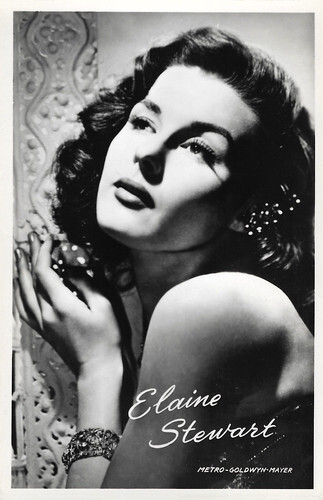
Dutch postcard by Takken / 't Sticht, no. 1814. Photo: Metro-Goldwyn-Mayer.

Italian postcard by Bromofoto, Milano, no. 827. Photo: Metro-Goldwyn-Mayer.
A charming co-hostess
Elaine Stewart left MGM around 1956. She appeared with James Stewart and Audie Murphy in the Western Night Passage (James Neilson, 1957). She co-starred with Jeff Chandler in the Film Noir The Tattered Dress (Jack Arnold, 1957), with Victor Mature in the Western Escort West (Francis D. Lyon, 1958) and shared top billing with John Derek in the adventure film, High Hell (Burt Balaban, 1958).
In the crime film The Rise and Fall of Legs Diamond (Budd Boetticher, 1960), she co-starred with Ray Danton and Karen Steele. In the early 1960s, she made a couple of films abroad. In Yugoslavia, she filmed with bodybuilder Ed Fury the Italian Peplum Le sette sfide/The Seven Revenges (Primo Zeglio, 1961), in which rival Mongol chiefs battle for leadership of the tribe.
Then she travelled to Mexico for the Science-Fiction film Most Dangerous Man Alive (1961), the final film of legendary director Allan Dwan. Ron Randell features as escaped mobster Ron Candell (!) who, after wandering in a nuclear testing area in the desert, starts mutating and seeks revenge on his former crime partners. Finally in Italy, she acted opposite Mark Damon, Dorian Gray and Daniela Rocca in Peccati d'estate/Island Affair (Giorgio Bianchi, 1962). It was her last film.
Her sultry allure could also be witnessed on such TV series as Bat Masterson (1960) and Burke's Law (1963), both starring Gene Barry. In her last acting appearance on TV, she played Irene Grey in the Perry Mason episode The Case of the Capering Camera (Jesse Hibbs, 1964).
Briefly married to actor Bill Carter in the early 1960s, she wed Emmy Award-winning game show creator Merrill Heatterin in 1964 and left her career to raise two children. In 1972, she became a charming co-hostess of the Heatter-Quigley game show Gambit (1972) with perennial game show emcee Wink Martindale and later partnered in the dice-rolling gamer High Rollers (1975) with Alex Trebek. Following an extended illness, the actress died in her home in Beverly Hills at the age of 81 in 2011. She was survived by her second husband Merrill Heatter, son Stewart Heatter and daughter Gabrielle Heatter. Upon her death, Elaine Stewart was promptly cremated.
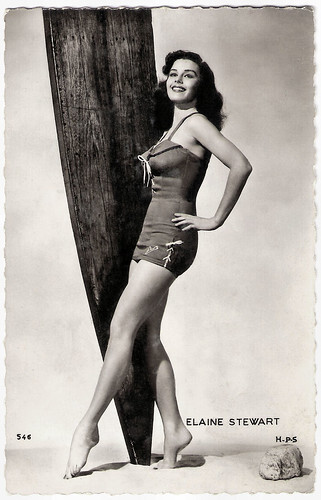
French postcard by Editions P.I., Paris, no. 546. Photo: H.P.S.
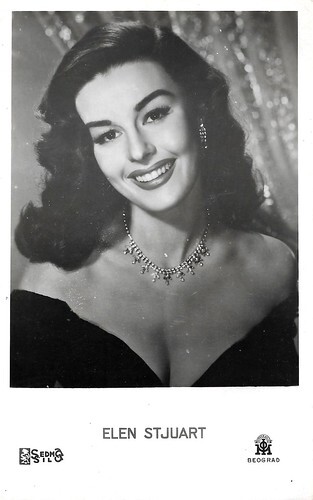
Yugoslavian postcard by Sedma Sila. Photo: Morava Film, Beograd (Belgrade).
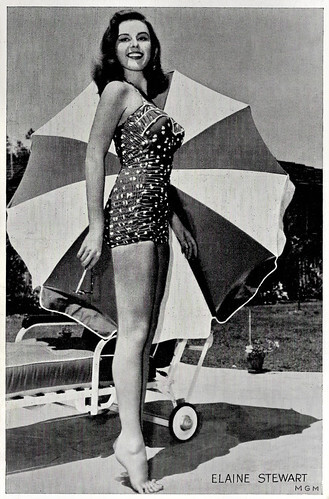
Vintage postcard. Photo: Metro-Goldwyn-Mayer.
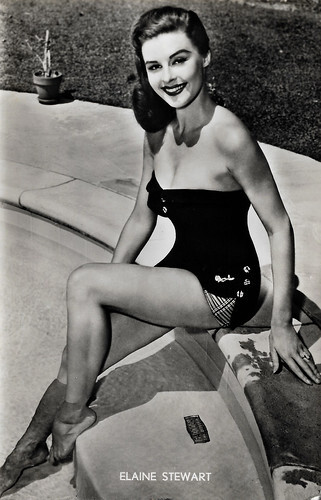
Dutch postcard.
Sources: (IMDb), Wikipedia and .

West German postcard by Universum-FilmAG, Abt. Film-Foto, Berlin-Tempelhof, no. FK 510. Photo: Metro-Goldwyn-Mayer. (The logo is printed in reverse).

British postcard in the Picturegoer Series, London, no. D. 387. Photo: Metro-Goldwyn-Mayer.

Vintage postcard by I.F.P.A., no. 8.
Miss See
Elaine Stewart was born Elsy Henrietta Maria Steinberg in Montclair, New Jersey, in 1930. She was the daughter of Jewish German immigrants, Maria Hedwig (Hänssler) and Ulrich Ernst Steinberg, a police sergeant. Elsy developed into a beautiful young woman and while still a teen, she was taken on by the Conover Modeling Agency.
She made her modelling debut by winning Miss See in See Magazine in 1952. Changing her name to the more glamorous-sounding Elaine Stewart, she was in many magazines such as Life and Photoplay. Her portfolio and beauty awards eventually caught the attention of Hollywood executives.
Hal B. Wallis offered her $200 a week to play the small, unbilled role of a nurse in the Dean Martin and Jerry Lewis slapstick comedy Sailor Beware (Hal Walker, 1952). MGM subsequently signed the glamour girl to a contract to build her up as a dark-haired Marilyn Monroe type. The build-up was gradual with window-dressing bits as a chorine, stewardess and the like in such MGM films as Singin' in the Rain (Stanley Donen, Gene Kelly, 1952), You for Me (Don Weis, 1952) and Everything I Have Is Yours (Robert Z. Leonard, 1952).
She then moved up to more visible parts in Sky Full of Moon (Norman Foster, 1952). During this time, she became a popular pin-up and made the cover of Life Magazine. She later appeared nude on the Playboy Magazine pages (September 1959). She had her breakthrough as Lila, the sexy lush and opportunist starlet who has a romantic fling with a producer played by Kirk Douglas and who has a marvellous "descending staircase" bit in The Bad and the Beautiful (Vincente Minnelli, 1952).
Stewart hit sultry "B" co-star status in the semi-documentary-styled police drama Code Two (Fred M. Wilcox, 1953) opposite Ralph Meeker. She had a small but key role, as the ill-fated queen Anne Boleyn, mother to Queen Elizabeth ( Jean Simmons ) in Young Bess (George Sidney, 1953). She was featured as Julie, the love interest of Sgt Ryan ( Richard Widmark ) and provided a lovely distraction in the macho war film Take the High Ground! (Richard Brooks, 1953). She co-starred with Mickey Rooney in the comedy, A Slight Case of Larceny (Don Weis, 1953). The next year, Stewart played a princess-in-peril in the Cinemascope Arabian adventure The Adventures of Hajji Baba (1954) starring John Derek. She also glamoured up the musical Brigadoon (Vincente Minnelli, 1954), co-starring with Gene Kelly , Van Johnson and Cyd Charisse.

Dutch postcard by Takken / 't Sticht, no. 1544. Photo: Metro-Goldwyn-Mayer.

Dutch postcard by Takken / 't Sticht, no. 1814. Photo: Metro-Goldwyn-Mayer.

Italian postcard by Bromofoto, Milano, no. 827. Photo: Metro-Goldwyn-Mayer.
A charming co-hostess
Elaine Stewart left MGM around 1956. She appeared with James Stewart and Audie Murphy in the Western Night Passage (James Neilson, 1957). She co-starred with Jeff Chandler in the Film Noir The Tattered Dress (Jack Arnold, 1957), with Victor Mature in the Western Escort West (Francis D. Lyon, 1958) and shared top billing with John Derek in the adventure film, High Hell (Burt Balaban, 1958).
In the crime film The Rise and Fall of Legs Diamond (Budd Boetticher, 1960), she co-starred with Ray Danton and Karen Steele. In the early 1960s, she made a couple of films abroad. In Yugoslavia, she filmed with bodybuilder Ed Fury the Italian Peplum Le sette sfide/The Seven Revenges (Primo Zeglio, 1961), in which rival Mongol chiefs battle for leadership of the tribe.
Then she travelled to Mexico for the Science-Fiction film Most Dangerous Man Alive (1961), the final film of legendary director Allan Dwan. Ron Randell features as escaped mobster Ron Candell (!) who, after wandering in a nuclear testing area in the desert, starts mutating and seeks revenge on his former crime partners. Finally in Italy, she acted opposite Mark Damon, Dorian Gray and Daniela Rocca in Peccati d'estate/Island Affair (Giorgio Bianchi, 1962). It was her last film.
Her sultry allure could also be witnessed on such TV series as Bat Masterson (1960) and Burke's Law (1963), both starring Gene Barry. In her last acting appearance on TV, she played Irene Grey in the Perry Mason episode The Case of the Capering Camera (Jesse Hibbs, 1964).
Briefly married to actor Bill Carter in the early 1960s, she wed Emmy Award-winning game show creator Merrill Heatterin in 1964 and left her career to raise two children. In 1972, she became a charming co-hostess of the Heatter-Quigley game show Gambit (1972) with perennial game show emcee Wink Martindale and later partnered in the dice-rolling gamer High Rollers (1975) with Alex Trebek. Following an extended illness, the actress died in her home in Beverly Hills at the age of 81 in 2011. She was survived by her second husband Merrill Heatter, son Stewart Heatter and daughter Gabrielle Heatter. Upon her death, Elaine Stewart was promptly cremated.

French postcard by Editions P.I., Paris, no. 546. Photo: H.P.S.

Yugoslavian postcard by Sedma Sila. Photo: Morava Film, Beograd (Belgrade).

Vintage postcard. Photo: Metro-Goldwyn-Mayer.

Dutch postcard.
Sources: (IMDb), Wikipedia and .
Published on November 17, 2023 22:00
Paul van Yperen's Blog
- Paul van Yperen's profile
- 13 followers
Paul van Yperen isn't a Goodreads Author
(yet),
but they
do have a blog,
so here are some recent posts imported from
their feed.



